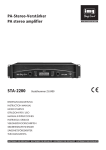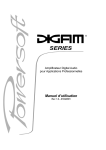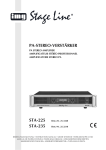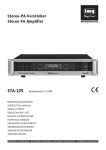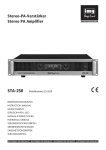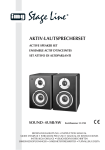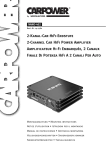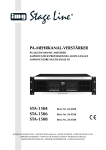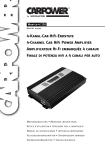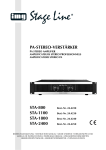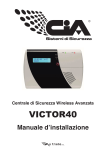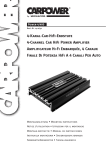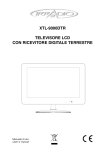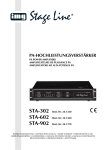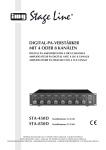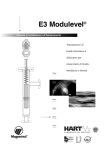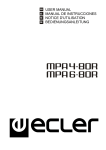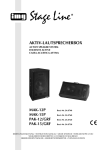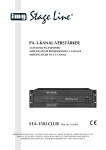Download STA-600 PA-STEREO-VERSTÄRKER
Transcript
PA-STEREO-VERSTÄRKER PA STEREO AMPLIFIER AMPLIFICATEUR STEREO PA AMPLIFICATORE STEREO PA STA-600 STA-1000 STA-1400 Best.-Nr. 25.0460 Best.-Nr. 25.0470 Best.-Nr. 25.0480 BEDIENUNGSANLEITUNG • INSTRUCTION MANUAL • MODE D’EMPLOI • ISTRUZIONI PER L’USO MANUAL DE INSTRUCCIONES • INSTRUKCJA OBSŁUGI • VEILIGHEIDSVOORSCHRIFTEN SIKKERHEDSOPLYSNINGER • SÄKERHETSFÖRESKRIFTER • TURVALLISUUDESTA D A CH Bevor Sie einschalten … Wir wünschen Ihnen viel Spaß mit Ihrem neuen Gerät von „img Stage Line“. Bitte lesen Sie diese Bedienungsanleitung vor dem Betrieb gründlich durch. Nur so lernen Sie alle Funktionsmöglichkeiten kennen, vermeiden Fehlbedienungen und schützen sich und Ihr Gerät vor eventuellen Schäden durch unsachgemäßen Gebrauch. Heben Sie die Anleitung für ein späteres Nachlesen auf. GB Der deutsche Text beginnt auf der Seite 4. F B CH Avant toute installation … Nous vous souhaitons beaucoup de plaisir à utiliser cet appareil “img Stage Line”. Lisez ce mode dʼemploi entièrement avant toute utilisation. Uniquement ainsi, vous pourrez apprendre lʼensemble des possibilités de fonctionnement de lʼappareil, éviter toute manipulation erronée et vous protéger, ainsi que lʼappareil, de dommages éventuels engendrés par une utilisation inadaptée. Conservez la notice pour pouvoir vous y reporter ultérieurement. Antes de la utilización … Le deseamos una buena utilización para su nuevo aparato “img Stage Line”. Por favor, lea estas instrucciones de uso atentamente antes de hacer funcionar el aparato. De esta manera conocerá todas las funciones de la unidad, se prevendrán errores de operación, usted y el aparato estarán protegidos en contra de todo daño causado por un uso inadecuado. Por favor, guarde las instrucciones para una futura utilización. I B Voor u inschakelt … Wij wensen u veel plezier met uw nieuwe apparaat van “img Stage Line”. Lees de veiligheidsvoorschriften grondig door, alvorens het apparaat in gebruik te nemen. Zo behoedt u zichzelf en het apparaat voor eventuele schade door ondeskundig gebruik. Bewaar de handleiding voor latere raadpleging. PL Innan du slår på enheten … Vi önskar dig mycket glädje med din nya “img Stage Line” produkt. Läs igenom säkerhetsföreskrifterna innan enheten tas i bruk för att undvika skador till följd av felaktig hantering. Behåll instruktionerna för framtida bruk. Säkerhetsföreskrifterna återfinns på sidan 16. 2 Vi auguriamo buon divertimento con il vostro nuovo apparecchio di “img Stage Line”. Leggete attentamente le istruzioni prima di mettere in funzione lʼapparecchio. Solo così potete conoscere tutte le funzionalità, evitare comandi sbagliati e proteggere voi stessi e lʼapparecchio da eventuali danni in seguito ad un uso improprio. Conservate le istruzioni per poterle consultare anche in futuro. Przed uruchomieniem … Życzymy zadowolenia z nowego produktu “img Stage Line”. Dzięki tej instrukcji obsługi będą państwo w stanie poznać wszystkie funkcje tego urządzenia. Stosując się do instrukcji unikną państwo błędów i ewentualnego uszkodzenia urządzenia na skutek nieprawidłowego użytkowania. Prosimy zachować instrukcję. Tekst polski zaczyna się na stronie 12. DK Før du tænder … Vi håber, du bliver glad for dit nye “img Stage Line” produkt. Læs sikkerhedsanvisningerne nøje før ibrugtagning, for at beskytte Dem og enheden mod skader, der skyldes forkert brug. Gem manualen til senere brug. Sikkerhedsanvisningerne findes på side 16. De veiligheidsvoorschriften vindt u op pagina 16. S Prima di accendere … Il testo italiano inizia a pagina 8. El texto en español empieza en la página 12. NL We wish you much pleasure with your new “img Stage Line” unit. Please read these operating instructions carefully prior to operating the unit. Thus, you will get to know all functions of the unit, operating errors will be prevented, and yourself and the unit will be protected against any damage caused by improper use. Please keep the operating instructions for later use. The English text starts on page 4. La version française se trouve page 8. E Before switching on … FIN Ennen kytkemistä … Toivomme Sinulle paljon miellyttäviä hetkiä uuden “img Stage Line” laitteen kanssa. Ennen laitteen käyttöä pyydämme Sinua huolellisesti tutustumaan turvallisuusohjeisiin. Näin vältyt vahingoilta, joita virheellinen laitteen käyttö saattaa aiheuttaa. Ole hyvä ja säilytä käyttöohjeet myöhempää tarvetta varten. Turvallisuusohjeet löytyvät sivulta 17. w w w. im gstage lin e .co m 1 2 3 9 10 4 5 6 7 8 11 12 13 14 15 16 13 STA-1400 Anschlussmöglichkeit je Ausgang Connecting possibility per output Betriebsart Mode Z je Lautsprecher Z per speaker STEREO, PARALLEL 4Ω BRIDGED 8Ω STEREO, PARALLEL + - STEREO, PARALLEL + + - - 16 Ω STEREO, PARALLEL 4Ω BRIDGED - BRIDGED + - 3 + + - - + + - - 8Ω STEREO, PARALLEL BRIDGED + 8Ω STEREO, PARALLEL STEREO, PARALLEL BRIDGED 16 Ω 4Ω 8Ω 4Ω 8Ω 8Ω STA-600 300 W 200 W PMIN je Lautsprecher • PMIN per speaker STA-1000 STA-1400 350 W 450 W 500 W 700 W 550 W 1000 W 1400 W 100 W 175 W 225 W 150 W 275 W 100 W 275 W 200 W 75 W 50 W 138 W 250 W 500 W 175 W 500 W 350 W 125 W 88 W 250 W 350 W 700 W 225 W 700 W 450 W 175 W 113 W 350 W D A Bitte klappen Sie die Seite 3 heraus. Sie sehen dann immer die beschriebenen Bedienelemente und Anschlüsse. CH Betriebsart STEREO 1 1.1 Übersicht der Bedienelemente und Anschlüsse 2 Status-LEDs für den linken Kanal: PROTECT leuchtet bei aktivierter Schutzschaltung (die Verbindung zu den Lautsprechern ist getrennt): 1. nach dem Einschalten für kurze Zeit 2. bei Überlastung/ Überhitzung (auch z. B. durch Kurzschluss am Ausgang) 3. bei Gleichspannung am Ausgang LIMITER leuchtet wenn das Eingangssignal zu groß ist und vom Limiter begrenzt wird ACTIVE leuchtet als Betriebsanzeige -25 dB, -20 dB, -15 dB zeigen den Eingangspegel an Betriebsart BRIDGE Signalmasse mit Gehäusemasse verbunden 10 Schalter FILTER mit den drei Positionen SUBWOOFER: Tiefpassfilter mit -6 dB bei 120 Hz SATELLITE: Hochpassfilter mit -6 dB bei 120 Hz FULLRANGE: kein Filter 4 Status-LEDs für den rechten Kanal ( Punkt 2) 13 Lautsprecherausgänge als Schraubklemmen 1.2 Rückseite 7 Symmetrische Eingänge als XLR-Buchsen für den linken (L-CH) und rechten (R-CH) Kanal 8 Symmetrische Eingänge als 6,3-mm-Klinkenbuchsen für den linken (L-CH) und rechten (RCH) Kanal Hinweise für den sicheren Gebrauch Das Gerät entspricht allen erforderlichen Richtlinien der EU und ist deshalb mit gekennzeichnet. WARNUNG Das Gerät wird mit lebensgefährlicher Netzspannung versorgt. Nehmen Sie deshalb niemals selbst Eingriffe am Gerät vor und stecken Sie nichts durch die Lüftungsöffnungen! Es besteht die Gefahr eines elektrischen Schlages. Im Betrieb liegt an den Lautsprecheranschlüssen berührungsgefährliche Spannung an. Alle Anschlüsse nur bei ausgeschaltetem Gerät vornehmen bzw. verändern. G Verwenden Sie das Gerät nur im Innenbereich und schützen Sie es vor Tropf- und Spritzwasser, hoher Luftfeuchtigkeit und Hitze (zulässiger Einsatztemperaturbereich 0 – 40 °C). G Stellen Sie keine mit Flüssigkeit gefüllten Gefäße, z. B. Trinkgläser, auf das Gerät. G Die in dem Gerät entstehende Wärme muss durch Luftzirkulation abgegeben werden. Decken Sie darum die Lüftungsöffnungen des Gehäuses nicht ab. G Nehmen Sie das Gerät nicht in Betrieb und ziehen Sie sofort den Netzstecker aus der Steckdose, 1. wenn sichtbare Schäden am Gerät oder an der Netzanschlussleitung vorhanden sind, 2. wenn nach einem Sturz oder Ähnlichem der Verdacht auf einen Defekt besteht, 3. wenn Funktionsstörungen auftreten. Geben Sie das Gerät in jedem Fall zur Reparatur in eine Fachwerkstatt. G Ziehen Sie den Netzstecker nie am Kabel aus der Steckdose, fassen Sie immer am Stecker an. G Verwenden Sie für die Reinigung nur ein trockenes, weiches Tuch, niemals Wasser oder Chemikalien. 11 Lautsprecherausgang als Speakon®-Buchse, je nach Steckerbelegung für den linken Kanal, den rechten Kanal oder für den Brückenbetrieb 12 Lautsprecherausgang als Speakon®-Buchse für den rechten Kanal 6 Ein-/Ausschalter POWER 2 Beachten Sie auch unbedingt die folgenden Punkte: Signalmasse und Gehäusemasse getrennt (groundlift) 3 LC-Display für Betriebsart und Temperaturen 5 Lautstärkeregler für den rechten Kanal R-CH 14 Nur bei den Modellen STA-600 und STA-1000: Halterung für die Netzsicherung Eine durchgebrannte Sicherung nur durch eine gleichen Typs ersetzen. 15 Nur bei dem Modell STA-1400: Schutzschalter zur Geräteabsicherung; zum Zurücksetzen des ausgelösten Schalters den Knopf hineindrücken 16 Netzbuchse zum Anschluss an eine Steckdose (230 V~ / 50 Hz) über das beiliegende Netzkabel Please unfold page 3. Then you can always see the operating elements and connections described. operating mode STEREO The unit corresponds to all required directives of the EU and is therefore marked with . 1 Operating Elements and Connections operating mode PARALLEL 1.1 Front panel WARNING The unit is supplied with hazardous mains voltage. Leave servicing to skilled personnel only and do not insert anything through the air vents! This may cause an electric shock hazard. There is a hazard of contact at the speaker connections with a dangerous voltage during operation. All connections must only be made or changed with the unit switched off. 1 Volume control for the left channel L-CH 2 Status LEDs for the left channel: PROTECT lights up with activated protective circuit (the connection to the speakers is separated): 1. after switching-on for a short time 2. in case of overload/overheating (e. g. also by short circuit at the output) 3. in case of DC voltage at the output LIMITER lights up when the input signal is too high and limited by the limiter ACTIVE lights up as a power indication -25 dB, -20 dB, -15 dB show the input level 3 LC display for operating mode and temperatures 4 Status LEDs for the right channel ( item 2) 2 operating mode BRIDGE signal ground connected to housing ground signal ground and housing ground separated (groundlift) 11 Speaker output: Speakon® jack, depending on plug configuration for the left channel, the right channel, or for bridge mode 6 POWER switch 13 Speaker outputs: screw terminals 7 Balanced inputs: XLR jacks for the left channel (L-CH) and the right channel (R-CH) 8 Balanced inputs: 6.3 mm jacks for the left channel (L-CH) and the right channel (R-CH) 9 DIP switches for selecting the operating mode and for separating signal ground and housing ground: The unit is suitable for indoor use only. Protect it against dripping water and splash water, high air humidity, and heat (admissible ambient temperature range 0 – 40 °C). G Do not place any vessels filled with liquid, e. g. drinking glasses, on the unit. G The heat being generated in the unit must be carried off by air circulation. Therefore, the air vents at the housing must not be covered. G Do not set the unit into operation, and immediately disconnect the mains plug from the mains socket if 1. there is visible damage to the unit or to the mains cable, 2. a defect might have occurred after a drop or similar accident, 3. malfunctions occur. The unit must in any case be repaired by skilled personnel. G Never pull the mains cable to disconnect the mains plug from the mains socket, always seize the plug. G For cleaning only use a dry, soft cloth, never use chemicals or water. SATELLITE: high pass filter with -6 dB at 120 Hz 12 Speaker output: Speakon® jack for the right channel Rear panel G SUBWOOFER: low pass filter with -6 dB at 120 Hz FULLRANGE: no filter 14 Only for models STA-600 and STA-1000: Support for the mains fuse Replace a blown fuse by one of the same type only. 15 Only for model STA-1400: Protective switch to protect the unit; to reset the released switch, press down the button 16 Mains jack for connection to a socket (230 V~/ 50 Hz) via the supplied mains cable Safety Notes It is essential to observe the following items: 10 Switch FILTER with three positions 5 Volume control for the right channel R-CH 1.2 4 Betriebsart PARALLEL Frontseite 1 Lautstärkeregler für den linken Kanal L-CH GB 9 DIP-Schalter zur Wahl der Betriebsart und zur Trennung von Signal- und Gehäusemasse: G Wird das Gerät zweckentfremdet, nicht richtig bedient, falsch angeschlossen oder nicht fachgerecht repariert, kann keine Haftung für daraus resultierende Sach- oder Personenschäden und keine Garantie für das Gerät übernommen werden. Soll das Gerät endgültig aus dem Betrieb genommen werden, übergeben Sie es zur umweltgerechten Entsorgung einem örtlichen Recyclingbetrieb. digt werden können. Bei unzureichendem Wärmeabfluss in das Rack eine Lüftereinheit einsetzen. Damit das Rack nicht kopflastig wird, muss der Verstärker im unteren Bereich des Racks eingeschoben werden. Für eine sichere Befestigung reicht die Frontplatte allein nicht aus. Zusätzlich muss das Gerät an der Rückseite befestigt oder über Seitenschienen oder eine Bodenplatte gehalten werden. 5 3 Einsatzmöglichkeiten Dieser PA-Stereo-Verstärker ist speziell für den Einsatz auf der Bühne und in der Diskothek konzipiert. Er kann im Stereobetrieb, im Mono-Parallelbetrieb oder im Mono-Brückenbetrieb genutzt werden. Durch ein schaltbares Filter kann der Verstärker auch nur für Subwoofer oder nur für den Frequenzbereich oberhalb von 120 Hz eingesetzt werden. Umfangreiche Schutzschaltungen schützen den Verstärker und die angeschlossenen Lautsprecher. Zwei leistungsstarke, temperaturgeregelte Lüfter sorgen für die nötige Kühlung des Verstärkers. 4 Aufstellmöglichkeiten Der Verstärker ist für den Einschub in ein Rack (482 mm/19") vorgesehen, kann aber auch als Tischgerät verwendet werden. In jedem Fall muss Luft ungehindert durch alle Lüftungsschlitze strömen können, damit eine ausreichende Kühlung gewährleistet ist. 4.1 Rackeinbau Verstärker anschließen Alle Anschlüsse dürfen nur bei ausgeschaltetem Gerät hergestellt oder verändert werden! 1) An die XLR- oder Klinkenbuchsen INPUTS (7, 8) den Ausgang eines Vorverstärkers oder eines Mischpults anschließen. Beide Buchsen sind für symmetrische Signale beschaltet; die Kontaktbelegung ist in Abbildung 2 dargestellt. Es können aber auch Quellen mit asymmetrischen Signalen angeschlossen werden. Dafür kann der Anschluss an die Klinkenbuchsen einfach über 2-polige Klinkenstecker erfolgen. Das Eingangssignal sollte Line-Pegel aufweisen. Für eine Vollaussteuerung des Verstärkers ist ein Eingangssignal von mindestens 1 V erforderlich. Für den Brücken- oder Parallelbetrieb nur den Eingang des linken Kanals L-CH anschließen. Die XLR-Buchse (7) ist jeweils direkt mit der Klinkenbuchse (8) desselben Kanals verbunden. So kann beim Anschluss der Signalquelle an eine Buchse das Signal von der anderen Buchse abgenommen werden, um es z. B. zu einem zusätzlichen Verstärker weiterzuleiten. Für die Rackmontage werden 2 HE (Höheneinheiten) = 89 mm benötigt. Die vom Verstärker rückseitig ausgeblasene, erhitzte Luft muss aus dem Rack austreten können. Anderenfalls kommt es im Rack zu einem Hitzestau, wodurch nicht nur der Verstärker, sondern auch andere Geräte im Rack beschä- 2) Die größte Ausgangsleistung wird im Stereobetrieb und im Parallelbetrieb beim Anschluss von 4-ΩLautsprechern (minimal zulässige Lastimpedanz) erreicht. Es können auch 8-Ω-Lautsprecher angeschlossen werden, was die Ausgangsleistung aber etwas verringert. Im Brückenbetrieb wird die G No guarantee claims for the unit and no liability for any resulting personal damage or material damage will be accepted if the unit is used for other purposes than originally intended, if it is not correctly connected or operated, or not repaired in an expert way. exceeding 120 Hz. Extensive protective circuits protect the amplifier and the speakers connected. Two powerful, temperature-controlled fans supply the necessary cooling of the amplifier. G Important for U. K. Customers! The wires in this mains lead are coloured in accordance with the following code: green/yellow = earth blue = neutral brown = live As the colours of the wires in the mains lead of this appliance may not correspond with the coloured markings identifying the terminals in your plug, proceed as follows: 1. The wire which is coloured green and yellow must be connected to the terminal in the plug which is marked with the letter E or by the earth symbol , or coloured green or green and yellow. 2. The wire which is coloured blue must be connected to the terminal which is marked with the letter N or coloured black. 3. The wire which is coloured brown must be connected to the terminal which is marked with the letter L or coloured red. 4 Warning – This appliance must be earthed. If the unit is to be put out of operation definitively, take it to a local recycling plant for a disposal which is not harmful to the environment. 3 Applications This PA stereo amplifier has especially been designed for stage and disco applications. The amplifier may be operated in stereo mode, in mono parallel mode, or in mono bridge mode. Due to a switchable filter the amplifier may also be used only for subwoofers or only for the frequency range Setting-Up The amplifier is provided for installation into a rack (482 mm/19"), but it may also be used as a table top unit. In each case air must be allowed to flow freely through all ventilation slots so that a sufficient cooling is ensured. 4.1 Rack installation For rack mounting 2 rs (rack spaces) = 89 mm are required. The heated air blown out by the amplifier at the rear must be able to dissipate from the rack, otherwise a heat accumulation will occur in the rack which may not only damage the amplifier but also other units in the rack. In case the heat is not dissipated sufficiently, a fan unit has to be inserted into the rack. To prevent top-heaviness of the rack, the amplifier must be inserted in the lower part of the rack. To ensure a safe fixing, the front panel alone is not sufficient. In addition, the unit must be fastened at the rear side or be supported by means of lateral rails or a bottom plate. 5 Connecting the Amplifier All connections must only be made or changed with the unit switched off! 1) Connect the output of a preamplifier or mixer to the XLR jacks or 6.3 mm jacks INPUTS (7, 8). Both jacks are designed for balanced signals; the pin configuration is shown in fig. 2. However, also sources with unbalanced signals may be connected. For this purpose the connection to the 6.3 mm jacks can easily be made via 2-pole 6.3 mm plugs. größte Ausgangsleistung mit einem 8-Ω-Lautsprecher (minimal zulässige Lastimpedanz im Brückenbetrieb) erreicht. Die erforderliche Nennbelastbarkeit (PMIN) der Lautsprecher ist in der Tabelle Abb. 3 aufgeführt. An die Speakon®-Buchsen (11, 12), Kontaktbelegung des Steckers siehe Abb. 2, oder an die Schraubklemmen (13) die Lautsprecher anschließen. Beim Anschluss der Lautsprecher ist auf die gleiche Polung aller Lautsprecher zu achten. Einen Speakon®-Stecker nach dem Einstecken in die Buchse nach rechts drehen, bis er einrastet. Zum späteren Herausziehen den Sicherungsriegel am Stecker zurückziehen und den Stecker nach links drehen. Werden die Schraubklemmen genutzt, darauf achten, dass die Kabelenden nicht zu weit abisoliert sind und keine blanken Drähte herausragen (Berührungs- und Kurzschlussgefahr). Die Speakon®-Buchse des Ausgangs L-CH (11) ist zusätzlich mit den Signalen des rechten Ausgangs R-CH belegt, so dass es auch möglich ist, beide Lautsprecher über ein vierpoliges Kabel an diese Buchse anzuschließen. Für den Brückenbetrieb den Pluskontakt des Lautsprechers mit der Plusklemme (13) des linken Ausgangs L-CH verbinden und den Minuskontakt des Lautsprechers mit der Plusklemme des rechten Ausgangs R-CH [siehe Abb. 2]. (Die Plusklemme des rechten Ausgangs wird durch die Signalinvertierung im Brückenbetrieb zum Minusanschluss für den Lautsprecher.) Der Lautsprecher kann alternativ auch an die Speakon®Buchse L-CH (11) angeschlossen werden. Dabei entsprechend Abb. 2 die Plusklemme des Lautsprechers an den Kontakt 1+ und die Minusklemme an den Kontakt 2+ des Steckers anschließen. In der Tabelle Abb. 3 sind auch Anschlussmöglichkeiten für mehrere Lautsprecher an einem Ausgang aufgeführt. Dazu ist jeweils angegeben, welche Nennbelastbarkeit (PMIN) The input signal should have line level. For rated power of the amplifier an input signal of 1 V is required as a minimum. For bridge mode or parallel mode only connect the input of the left channel L-CH. The XLR jack (7) is in each case directly connected to the 6.3 mm jack (8) of the same channel. Thus, when connecting the signal source to a jack, the signal of the other jack can be picked up to feed it e. g. to an additional amplifier. D A CH GB 2) The maximum output power is reached in stereo mode and in parallel mode when connecting 4 Ω speakers (minimum admissible load impedance). It is also possible to connect 8 Ω speakers, however, in this case the output power will slightly decrease. In bridge mode the maximum output power will be reached with an 8 Ω speaker (minimum admissible load impedance in bridge mode). The required power rating (PMIN) of the speakers is listed in the table fig. 3. Connect the speakers to the Speakon® jacks (11, 12), pin configuration of the plug see fig. 2, or to the screw terminals (13). When connecting the speakers, pay attention to the same polarity of all speakers. After connecting a Speakon® plug to the jack, turn it clockwise until it locks into place. For removing it later, retract the lock latch at the plug and turn the plug counter-clockwise. If the screw terminals are used, ensure that the cable ends are not stripped too far and that no bare wires protrude (hazard of contact and short circuit). The Speakon® jack of the output L-CH (11) is additionally provided with the signals of the right output R-CH so that it is also possible to connect both speakers via a 4-pole cable to this jack. For bridge mode connect the positive contact of the speaker to the positive terminal (13) of the left output L-CH and the negative contact of the speaker to the positive terminal of the right output 5 jeder Lautsprecher bei entsprechender Impedanz (Z) mindestens haben muss. Beim Zusammenschalten von mehreren Lautsprechern ist besonders auf die richtige Verbindung der Plusund Minusanschlüsse zu achten. D A CH Wichtig: Die Gesamtimpedanz an jedem Ausgang darf im Stereo- und Parallelbetrieb 4 Ω, im Brückenbetrieb 8 Ω nicht unterschreiten! 3) Das Netzkabel erst in die Netzbuchse (16) und dann den Netzstecker des Anschlusskabels in eine Steckdose (230 V~/ 50 Hz) stecken. 6 Bedienung 6.1 Betriebsart wählen Mit den DIP-Schaltern MODE Nr. 1 – 6 (9) die gewünschte Betriebsart wählen: Stereobetrieb – „MODE STEREO“ Im Stereobetrieb werden beide Kanäle unabhängig voneinander betrieben. Schalterkonstellation STEREO Parallelbetrieb – „MODE PARALLEL“ Sollen z. B. zwei Räume mit demselben Mono-Signal beschallt werden und die Lautstärke einzeln einstellbar sein, bietet sich der Parallelbetrieb an. Das Eingangssignal wird intern vom linken Kanal zusätzlich auf den rechten Kanal geschaltet. Ein Signal am rechten Eingang wird ignoriert. Die Lautstärkeeinstellung erfolgt für beide Ausgänge separat. Schalterkonstellation PARALLEL R-CH [see fig. 2]. (By the signal inversion in bridge mode, the positive terminal of the right output becomes the negative connection for the speaker.) The speaker can alternatively also be connected to the Speakon® jack L-CH (11). According to fig. 2 connect the positive terminal of the speaker to contact 1+ and the negative terminal to contact 2+ of the plug. Table fig. 3 also shows possibilities of connection for several speakers to one output. In each case it is stated which power rating (PMIN) each speaker must have as a minimum with the corresponding impedance (Z). When interconnecting several speakers, special attention has to be paid to the correct connection of the positive and negative terminals. GB Important: The total impedance at each output must not fall below 4 Ω in stereo mode and parallel mode and must not fall below 8 Ω in bridge mode! 3) First connect the mains cable to the mains jack (16) and then the mains plug of the cable to a socket (230 V~/ 50 Hz). Brückenbetrieb – „MODE BRIDGE“ Der Brückenbetrieb (BRIDGE) dient dazu, an einem Lautsprecher eine größere Leistung zu erhalten. Dazu werden beide Verstärkerkanäle zu einem Monoverstärker kombiniert: Das Eingangssignal am linken Kanal wird zusätzlich invertiert auf den rechten Kanal geschaltet. Dadurch verdoppelt sich die Spannung am Ausgang, wenn der Lautsprecher, wie in Kap. 5 beschrieben, für den Brückenbetrieb angeschlossen ist. Ein Signal am rechten Eingang wird ignoriert. Die Lautstärkeeinstellung erfolgt für beide Ausgänge gemeinsam mit dem linken Regler (1). Schalterkonstellation BRIDGE 6.2 Filter Das eingebaute Filter kann als Frequenzweiche für 2-Wege-Lautsprechersysteme (Subwoofer/ Satellite) verwendet werden. Mit dem Schalter FILTER (10) die dem angeschlossenen Lautsprecher entsprechende Funktion wählen. Position SUBWOOFER: Tiefpassfilter mit -6 dB bei 120 Hz für Tieftonlautsprecher Position SATELLITE: Hochpassfilter mit -6 dB bei 120 Hz für Mittelhochtonlautsprecher Position FULLRANGE: kein Filter für Breitbandlautsprecher 6.3 Ein-/Ausschalten Zur Vermeidung von lauten Schaltgeräuschen den Endverstärker in einer Verstärkeranlage immer nach allen anderen Geräten einschalten und ihn nach dem Betrieb als erstes Gerät wieder ausschalten. Vor dem ersten Einschalten die Regler (1 und 5) ganz nach links auf „-80 dB“ drehen. Den Verstärker mit dem Schalter POWER (6) einschalten. Die ACTIVE-LEDs (2, 4) leuchten als nal and to be capable of adjusting the volume individually. The input signal is internally switched from the left channel additionally to the right channel. A signal at the right input is ignored. The volume is separately adjusted for both outputs. switch configuration PARALLEL Bridge mode – display: “MODE BRIDGE” The bridge mode (BRIDGE) serves to obtain a higher power at one speaker. For this purpose both amplifier channels are combined to one mono amplifier: The input signal of the left channel is additionally switched to the right channel in an inverted way. Thus, the voltage at the output is doubled if the speaker is connected for bridge mode, as described in chapter 5. A signal at the right input is ignored. The volume is adjusted with the left control (1) together for both outputs. switch configuration BRIDGE 6 Operation 6.1 Selecting the operating mode Select the desired operating mode with the DIP switches MODE Nos. 1 to 6 (9): Stereo mode – display: “MODE STEREO” In stereo mode, both channels are operated independently of each other. switch configuration STEREO Parallel mode – display: “MODE PARALLEL” Parallel mode is recommended to provide PA applications e. g. for two rooms with the same mono sig- 6 6.2 Betriebsanzeige und das Display (3) zeigt die gewählte Betriebsart. Nach dem Einschalten leuchten für kurze Zeit die roten PROTECT-LEDs (2, 4). In dieser Zeit ist die Einschaltverzögerung zum Schutz der Lautsprecher aktiviert. 6.4 VORSICHT Stellen Sie die Lautstärke am Verstärker nie sehr hoch ein. Hohe Lautstärken können auf Dauer das Gehör schädigen! Das Ohr gewöhnt sich an große Lautstärken und empfindet sie nach einiger Zeit als nicht mehr so hoch. Darum eine hohe Lautstärke nach der Gewöhnung nicht weiter erhöhen. 6.5 Schalterkonstellation Groundlift 6.3 Position FULLRANGE: no filter for full range speakers Switching on/off To prevent loud switching noise, always switch on the power amplifier in an amplifier system after all other units have been switched on and switch it off first after operation. Prior to first switching-on, set the controls (1 and 5) to the left stop to “-80 dB”. Switch on the amplifier with the POWER switch (6). The ACTIVE LEDs (2, 4) serve as a power indication and the display (3) shows the selected operating mode. After switching-on, the red LEDs PROTECT (2, 4) light up for a short time. During this time the switchon delay is activated to protect the speakers. 6.4 Level adjustment Adjust the output of the mixer or preamplifier to its rated level (0 dB) or the maximum undistorted output signal. Turn up the controls (1 and 5) so far until the maximum desired volume is reached. The LEDs “-25 dB”, “-20 dB”, and “-15 dB” (2, 4) show the adjusted input level. If the red LEDs LIMITER light up, the limiter circuit is active and prevents overload of the amplifier. In this case slightly turn back the controls. CAUTION Filter Position SATELLITE: High pass filter with -6 dB at 120 Hz for mid-high range speakers Groundlift-Schalter Ist ohne ein Musiksignal ein störendes Brummen zu hören, kann eine Masseschleife die Ursache sein. Masseschleifen können entstehen, wenn zwei Geräte sowohl über die Signalmasse als auch über den Schutzleiter der Stromversorgung oder eine leitende Verbindung der Gehäuse im Rack Kontakt haben. Um die so entstandene Masseschleife aufzutrennen, die DIP-Schalter Nr. 7 und Nr. 8 (9) von der oberen in die untere Position stellen: The integrated filter can be used as a crossover network for 2-way speaker systems (subwoofer/satellite). Select the function corresponding to the connected speaker with the switch FILTER (10). Position SUBWOOFER: Low pass filter with -6 dB at 120 Hz for bass speakers Pegel einstellen Den Ausgang des Mischpultes oder Vorverstärkers auf seinen Nennpegel (0 dB) oder das größte unverzerrte Ausgangssignal aussteuern. Die Regler (1 und 5) so weit aufdrehen, bis die maximal gewünschte Lautstärke erreicht ist. Die LEDs „-25 dB“, „-20 dB“ und „-15 dB“ (2, 4) zeigen den eingestellten Eingangspegel an. Leuchten die roten LIMITERLEDs, ist die Begrenzerschaltung aktiv und verhindert die Übersteuerung des Verstärkers. In diesem Fall die Regler etwas zurückdrehen. 6.5 Never adjust the amplifier to a very high volume. Permanent high volumes may damage your hearing! The human ear will get accustomed to high volumes which do not seem to be that high after some time. Therefore, do not further increase a high volume after getting used to it. Groundlift switch If an interfering hum noise can be heard without a music signal, a ground loop may be the reason for this. Ground loops may occur if two units have contact both via the signal ground and via the earthed conductor of the power supply or a conductive connection of the housings in the rack. To separate the ground loop thus occurring, set the DIP switches No. 7 Schutzschaltungen Die Schutzschaltungen sollen Beschädigungen der Lautsprecher und des Verstärkers verhindern. Der eingebaute Pegelbegrenzer (Limiter) regelt das Eingangssignal zurück, wenn der Grenzpegel am Ausgang erreicht wird. Dadurch lassen sich bei Übersteuerung des Verstärkers Verzerrungen vermeiden, die die Lautsprecher schädigen könnten. Ist der Begrenzer aktiv, leuchtet die LIMITER-LED (2, 4) des entsprechenden Kanals. Durch eine zusätzliche Schutzschaltung werden die Lautsprecher vom Ausgang des betroffenen Kanals getrennt. Ist sie aktiv, leuchtet die entsprechende rote PROTECT-LED (2, 4): 1. für kurze Zeit nach dem Einschalten (Einschaltverzögerung) 2. bei Überlastung/ Überhitzung (auch z. B. durch Kurzschluss am Ausgang) 3. wenn eine Gleichspannung am Ausgang auftritt Im normalen Betrieb wird im Display (3) die Temperatur an den Leistungstransistoren für beide Kanäle getrennt angezeigt. Bei höheren Temperaturen sorgt die Lüfterregelung dafür, dass der Lüfter des betroffenen Kanals mit einer höheren Geschwindigkeit läuft. Bei einem Fehler, wie z. B. einem Kurzschluss an einem Ausgang, wechselt (zusätzlich zu dem Leuchten der PROTECT-LED des betroffenen Kanals) die Anzeige auf „SHORT CIR.PROT, OVERLOAD&FAULT“. In diesem Fall oder wenn eine PROTECT-LED nach dem Einschalten nicht erlischt oder wenn der Schutzschalter (15) ausgelöst hat (nur beim Modell STA-1400), muss der Verstärker ausgeschaltet und die Fehlerursache behoben werden. Wenn erforderlich, den Schutzschalter durch Hineindrücken wieder zurücksetzen. 8 Technische Daten D A Modell STA-600 STA-1000 STA-1400 Sinus-Ausgangsleistung (1 kHz, 0,1 % THD+N) Stereo, Parallel an 4 Ω Stereo, Parallel an 8 Ω Brückenbetrieb an 8 Ω 2 × 300 W 2 × 200 W 550 W 2 × 500 W 2 × 350 W 1000 W 2 × 700 W 2 × 450 W 1400 W Eingangsempfindlichkeit für Nennleistung an 8 Ω CH 1V Eingangsimpedanz sym./ asym. 20 kΩ/10 kΩ Frequenzbereich bei 1 W an 8 Ω 20 – 20 000 Hz (±0,3 dB) Hochpassfilter/ Tiefpassfilter 120 Hz (-6 dB), 24 dB/ Oktave > 300 Dämpfungsfaktor an 8 Ω Klirrfaktor* < 0,1 % Kanaltrennung* > 60 dB Störabstand bei Nennleistung an 8 Ω > 95 dB *20 Hz – 20 kHz bei Nennleistung an 8 Ω Ausgangsschaltung Class AB Einsatztemperatur 0 – 40 °C Stromversorgung 230 V~/ 50 Hz 230 V~/ 50 Hz 230 V~/ 50 Hz max. Leistungsaufnahme 1000 VA 1600 VA 2300 VA Abmessungen (B × H × T) 482 × 88 × 418 mm, 482 × 88 × 418 mm, 482 × 88 × 418 mm, 2 HE 2 HE 2 HE 12,5 kg 15 kg 16,7 kg Gewicht Änderungen vorbehalten. Diese Bedienungsanleitung ist urheberrechtlich für MONACOR ® INTERNATIONAL GmbH & Co. KG geschützt. Eine Reproduktion für eigene kommerzielle Zwecke – auch auszugsweise – ist untersagt. 7 and No. 8 (9) from the upper position to the lower position. switch configuration Groundlift 7 Protective Circuits The protective circuits are provided to prevent damage to the speakers and to the amplifier. The integrated level limiter reduces the input signal when the limit level at the output is reached. Thus, in case of overload of the amplifier, distortions can be prevented which might damage the speakers. If the limiter is active, the LED LIMITER (2, 4) of the corresponding channel lights up. Due to an additional protective circuit the speakers are separated from the output of the channel concerned. If it is active, the corresponding red LED PROTECT (2, 4) lights up: 8 Specifications GB Model STA-600 STA-1000 STA-1400 RMS output power (1 kHz, 0,1 % THD+N) Stereo, parallel at 4 Ω Stereo, parallel at 8 Ω Bridge mode at 8 Ω 2 × 300 W 2 × 200 W 550 W 2 × 500 W 2 × 350 W 1000 W 2 × 700 W 2 × 450 W 1400 W Input sensitivity for rated power at 8 Ω 1V Input impedance bal./ unbal. 20 kΩ/10 kΩ Frequency range with 1 W at 8 Ω 20 – 20 000 Hz (±0.3 dB) High pass filter/low pass filter 120 Hz (-6 dB), 24 dB/ octave > 300 Attenuation factor at 8 Ω THD* < 0.1 % Channel separation* > 60 dB 1. for a short time after switching-on (switch-on delay) S/N ratio with rated power at 8 Ω > 95 dB 2. in case of overload/overheating (e. g. also by short circuit at the output) Output circuit 3. if a DC voltage occurs at the output During normal operation the temperature at the power transistors is shown on the display (3) separately for both channels. With higher temperatures the fan control ensures that the fan of the channel concerned runs at a higher speed. In case of a defect, e. g. a short circuit at an output, the display changes to “SHORT CIR.PROT, OVERLOAD&FAULT” (in addition, the LED PROTECT of the channel concerned lights up). In this case, or if the LED PROTECT is not extinguished after switching-on, or if the protective switch (15) has been released (only for model STA-1400), the amplifier must be switched off and the cause for the defect must be eliminated. If required, reset the protective switch by pressing it down. *20 Hz – 20 kHz with rated power at 8 Ω class AB Ambient temperature 0 – 40 °C Power supply 230 V~/ 50 Hz 230 V~/ 50 Hz 230 V~/ 50 Hz Max. power consumption 1000 VA 1600 VA 2300 VA Dimensions (W × H × D) 482 × 88 × 418 mm, 482 × 88 × 418 mm, 482 × 88 × 418 mm, 2 RS 2 RS 2 RS 12.5 kg 15 kg 16.7 kg Weight Subject to technical modification. All rights reserved by MONACOR ® INTERNATIONAL GmbH & Co. KG. No part of this instruction manual may be reproduced in any form or by any means for any commercial use. 7 F B CH Ouvrez le présent livret page 3 de manière à visualiser les éléments et branchements. 1 Eléments et branchements 1.1 Face avant 1 Potentiomètre de réglage de volume pour le canal gauche L-CH 2 LEDs dʼétat pour le canal gauche : PROTECT : brille lorsque le circuit de protection est activé (la liaison avec les haut-parleurs est coupée) : 9 Interrupteurs DIP pour sélectionner le mode de fonctionnement et séparer la masse du signal et la masse du boîtier :: mode de fonctionnement STEREO mode de fonctionnement PARALLEL mode de fonctionnement BRIDGE masse du signal reliée à la masse du boîtier 1. Après lʼallumage pendant une brève période 2. en cas de surcharge/ surchauffe (par exemple en cas de court-circuit en sortie) 3. en cas de présence de tension continue en sortie LIMITER : brille lorsque le signal dʼentrée est trop élevé et est limité par le limiteur ACTIVE : brille comme témoin de fonctionnement 10 Interrupteur FILTER avec trois positions : SUBWOOFER : filtre passe-bas avec -6 dB à 120 Hz SATELLITE : filtre passe-haut avec -6 dB à 120 Hz FULLRANGE : aucun filtre -25 dB, -20 dB, -15 dB indiquent le niveau dʼentrée selon la 11 Sortie haut-parleur, prise configuration de la fiche pour le canal gauche, le canal droit ou le mode bridgé 3 Affichage LCD pour le mode de fonctionnement et les températures 12 Sortie haut-parleur, prise Speakon® pour le canal droit 4 LEDs dʼétat pour le canal droit ( point 2) 5 Potentiomètre de réglage de volume pour le canal droit R-CH 6 Interrupteur Marche/Arrêt POWER Speakon®, 8 Entrées symétriques, prises jack 6,35 femelles pour le canal gauche (L-CH) et le canal droit (R-CH) 16 Prise secteur à relier, via le cordon secteur livré, à une prise secteur 230 V~/ 50 Hz Vi preghiamo di aprire completamente la pagina 3. Così vedrete sempre gli elementi di comando e i collegamenti descritti. 9 DIP-switch per la scelta del modo di funzionamento e per la separazione fra massa dei segnali e del contenitore: 1 1.1 Elementi di comando e collegamenti Modo di funzionamento STEREO Modo di funzionamento PARALLEL Pannello frontale 1 Regolatore volume per il canale sinistro L-CH Modo di funzionamento BRIDGE 2 LED di stato per il canale sinistro: PROTECT è acceso con il circuito di protezione attivato (il collegamento con gli altoparlanti è staccato): 1. per un breve tempo dopo lʼaccensione 2. in caso di sovraccarico/surriscaldamento (p. es. anche in seguito a cortocircuito allʼuscita) 3. in caso di tensione continua allʼuscita LIMITER è acceso se il segnale dʼingresso è troppo forte e se viene limitato dal limiter ACTIVE è acceso come spia di funzionamento -25 dB, -20 dB, -15 dB indicano il livello allʼingresso 3 Display a LC per il modo di funzionamento e le temperature 4 LED di stato per il canale destro ( punto 2) 5 Regolatore volume per il canale destro R-CH 6 Interruttore on/off POWER 8 Massa dei segnali collegata con la massa del contenitore Massa dei segnali separata dalla massa del contenitore (groundlift) 10 Commutatore FILTER con le tre posizioni SUBWOOFER: filtro passa-basso a -6 dB con 120 Hz SATELLITE: filtro passa-alto a -6 dB con 120 Hz FULLRANGE: nessun filtro 11 Uscita altoparlanti come presa Speakon®, a seconda dei contatti, per il canale sinistro, per il canale destro o per il funzionamento a ponte 12 Uscita altoparlanti come presa Speakon® per il canale destro G Lʼappareil nʼest conçu que pour une utilisation en intérieur. Protégez-le des éclaboussures, de tout type de projections dʼeau, dʼune humidité dʼair élevée et de la chaleur (température ambiante admissible 0 – 40 °C). G En aucun cas, vous ne devez pas poser dʼobjet contenant du liquide ou un verre sur lʼappareil. G La chaleur dégagée par lʼappareil doit être évacuée par une circulation dʼair correcte. Nʼobstruez pas les ouïes de ventilation du boîtier. G Ne faites pas fonctionner lʼappareil et débranchez le cordon secteur immédiatement dans les cas suivants : 1. lʼappareil ou le cordon secteur présentent des dommages visibles. 2. après une chute ou accident similaire, vous avez un doute sur lʼétat de lʼappareil. 3. des dysfonctionnements apparaissent. Dans tous les cas, les dommages doivent être réparés par un technicien spécialisé. G Ne débranchez jamais lʼappareil en tirant sur le cordon secteur ; retirez toujours le cordon secteur en tirant la fiche. 2 8 Ingressi simmetrici come prese jack 6,3mm per i canali sinistro (L-CH) e destro (R-CH) 16 Presa per il collegamento con un a presa di rete (230 V~/50 Hz) tramite il cavo in dotazione Avvertenze di sicurezza Questʼapparecchio è conforme a tutte le direttive richieste dellʼUE e pertanto porta la sigla . AVVERTIMENTO Lʼapparecchio funziona con pericolosa tensione di rete. Non intervenire mai personalmente al suo interno e non inserire niente nelle fessure di aerazione! Esiste il pericolo di una scarica elettrica. Durante il funzionamento, ai contatti degli altoparlanti è presente una tensione pericolosa. Effettuare o modificare tutti i collegamenti solo con lʼapparecchio spento. Si devono osservare assolutamente anche i seguenti punti: G Usare lʼapparecchio solo allʼinterno di locali e proteggerlo dallʼacqua gocciolante e dagli spruzzi dʼacqua, da alta umidità dellʼaria e dal calore (temperatura dʼimpiego ammessa fra 0 e 40 °C). G Non depositare sullʼapparecchio dei contenitori riempiti di liquidi, p. es. bicchieri. G Devʼessere garantita la libera circolazione dellʼaria per dissipare il calore che viene prodotto allʼinterno dellʼapparecchio. Non coprire in nessun modo le fessure di aerazione. G Non mettere in funzione lʼapparecchio e staccare subito la spina rete se: 1. lʼapparecchio o il cavo rete presentano dei danni visibili; 2. dopo una caduta o dopo eventi simili sussiste il sospetto di un difetto; 3. lʼapparecchio non funziona correttamente. Per la riparazione rivolgersi sempre ad unʼofficina competente. G Staccare il cavo rete afferrando la spina, senza tirare il cavo. G Per la pulizia usare solo un panno morbido, asciutto; non impiegare in nessun caso prodotti chimici o acqua. 14 Solo nei modelli STA-600 e STA-1000: Porta fusibile Sostituire un fusibile difettoso sempre con uno dello stesso tipo. 7 Ingressi simmetrici come prese XLR per i canali sinistro (L-CH) e destro (R-CH) Lato posteriore Respectez scrupuleusement les points suivants : 13 Uscita altoparlanti come morsetti a vite 15 Solo con il modello STA-1400: Interruttore automatico di protezione per lʼapparecchio; per resettare lʼinterruttore attivato, premere il pulsante 1.2 AVERTISSEMENT Lʼappareil est alimenté par une tension dangereuse. Ne touchez jamais lʼintérieur de lʼappareil et ne faites rien tomber dans les ouïes de ventilation car, en cas de mauvaise manipulation, vous pouvez subir une décharge électrique. Pendant le fonctionnement, une tension dangereuse est présente aux bornes haut-parleurs. Les branchements ne doivent être effectués ou modifiés que lorsque lʼappareil est éteint. 14 Uniquement sur les modèles STA-600 et STA-1000 : porte fusible : tout fusible fondu doit être remplacé par un fusible de même type. 7 Entrées symétriques, prises XLR pour le canal gauche (L-CH) et le canal droit (R-CH) Face arrière Conseils de sécurité et dʼutilisation Lʼappareil répond à toutes les directives nécessaires de lʼUnion européenne et porte donc le symbole . 13 Sorties haut-parleurs, borniers à vis 15 Uniquement sur le modèle STA-1400 : interrupteur de protection pour la protection de lʼappareil : pour réinitialiser lʼinterrupteur déclenché, enfoncez le bouton. 1.2 I masse du signal et masse du boîtier séparées (groundlift) 2 G Pour le nettoyage, utilisez un chiffon sec et doux, en aucun cas de produits chimiques ou dʼeau. G Nous déclinons toute responsabilité en cas de dommages corporels ou matériels résultants si lʼappareil est utilisé dans un but autre que celui pour lequel il a été conçu, sʼil nʼest pas correctement branché, utilisé ou réparé par une personne habilitée ; en outre, la garantie deviendrait caduque. Lorsque lʼappareil est définitivement retiré du service, vous devez le déposer dans une usine de recyclage de proximité pour contribuer à son élimination non polluante. accumulation de chaleur dans le rack, ce qui peut endommager non seulement lʼamplificateur mais dʼautres appareils placés dans le rack. En cas de dégagement insuffisant de la chaleur, installez un ventilateur dans le rack. Afin que le rack ne se renverse pas, vous devez placer lʼamplificateur dans la partie inférieure du rack. Pour une fixation solide, la plaque avant seule nʼest pas suffisante, lʼamplificateur doit en plus, être maintenu par des rails latéraux ou une plaque inférieure. 5 3 Possibilités dʼutilisation Cet amplificateur professionnel stéréo est spécialement conçu pour une utilisation sur scène et en discothèque. Il peut fonctionner en mode stéréo, mono parallèle ou mono bridgé. Grâce au filtre commutable, lʼamplificateur peut être utilisé uniquement pour les subwoofers ou uniquement pour la plage de fréquences au-delà de 120 Hz. De multiples circuits de protection protègent lʼamplificateur et les haut-parleurs reliés. Deux ventilateurs puissants, contrôlés par la température, délivrent le refroidissement suffisant de lʼamplificateur. 4 Possibilités de positionnement Lʼamplificateur est conçu pour une installation en rack (482 mm/19") mais peut être également posé directement sur une table. Dans tous les cas, lʼair doit pouvoir passer sans encombre via les ouïes dʼaération pour assurer un refroidissement suffisant. 4.1 Installation en rack Pour un montage en rack, deux unités = 89 mm sont nécessaires. Lʼair chaud dégagé par lʼappareil à lʼarrière doit pouvoir être évacué du rack. Sinon, il y a G Nel caso dʼuso improprio, dʼimpiego scorretto, di collegamenti sbagliati o di riparazione non a regola dʼarte dellʼapparecchio, non si assume nessuna responsabilità per eventuali danni consequenziali a persone o a cose e non si assume nessuna garanzia per lʼapparecchio. Se si desidera eliminare lʼapparecchio definitivamente, consegnarlo per lo smaltimento ad unʼistituzione locale per il riciclaggio. 1) Reliez la sortie dʼun préamplificateur ou dʼune table de mixage aux prises XLR ou jack 6,35 INPUTS (7, 8). Les deux prises sont configurées pour des signaux symétriques ; la configuration est présentée sur le schéma 2. Des sources avec signaux asymétriques peuvent également être reliées. Dans ce cas, le branchement aux prises jack peut sʼeffectuer simplement via des fiches jack 6,35 2 pôles. Le signal dʼentrée devrait avoir un niveau Ligne. Pour une puissance nominale de lʼamplificateur, un signal dʼentrée doit être de 1 V au moins. Pour le mode bridgé ou parallèle, reliez uniquement lʼentrée du canal gauche L-CH. La prise XLR (7) est reliée directement à la fiche jack (8) du même canal. Ainsi, lorsquʼon branche la source de signal à une prise, le signal peut être pris de lʼautre prise, pour par exemple le diriger vers un autre amplificateur. 2) La puissance de sortie la plus importante est atteinte en mode stéréo et en mode parallèle avec des haut-parleurs 4 Ω (impédance en charge autorisée minimale). Il est également possible de brancher des haut-parleurs 8 Ω, ce qui rack. Se la dissipazione del calore è insufficiente occorre montare un ventilatore nel rack. Per evitare che il rack risulti squilibrato con troppi pesi in alto, è necessario che lʼamplificatore venga montato nella parte bassa del rack. Per un fissaggio sicuro non è sufficiente il pannello frontale. Lʼapparecchio deve essere fissato anche sul retro oppure deve essere appoggiato su guide laterali oppure su un piano. 5 3 Possibilità dʼimpiego Questo amplificatore PA stereo è stato realizzato specialmente per lʼimpiego sul palcoscenico e in discoteca. Può essere usato con funzionamento stereo, mono parallelo o mono a ponte. Grazie ad un filtro commutabile, lʼamplificatore può essere utilizzato anche solo per subwoofer oppure solo per le frequenze oltre 120 Hz. Vasti circuiti di protezione proteggono lʼamplificatore e gli altoparlanti collegati. Due ventilatori potenti, termoregolati, provvedono al raffreddamento necessario dellʼamplificatore. 4 Possibilità di collocamento Lʼamplificatore è previsto per lʼinserimento in un rack (482 mm/19"), ma può essere usato anche come apparecchio da tavolo. In ogni caso deve essere possibile che lʼaria possa circolare liberamente attraverso tutte le fessure di aerazione per garantire un raffreddamento sufficiente. 4.1 Montaggio nel rack Per il montaggio in un rack sono richieste due unità di altezza RS (= 89 mm). Lʼaria riscaldata emessa sul retro dellʼamplificatore deve potere uscire dal rack. Altrimenti si può provocare un accumulo di calore nel rack con possibili danni non solo allʼamplificatore ma anche ad altri apparecchi presenti nel Branchements de lʼamplificateur Les branchements ne doivent être effectués que lorsque lʼamplificateur est éteint ! Collegare lʼamplificatore Tutti i collegamenti devono essere effettuati o modificati solo con lʼapparecchio spento! 1) Collegare lʼuscita di un preamplificatore o di un mixer con le prese XLR o jack INPUTS (7, 8). Entrambe le prese sono previste per segnali simmetrici; i contatti si vedono in fig. 2. Tuttavia, si possono collegare anche sorgenti con segnali asimmetrici. In questo caso, il collegamento può essere fatto alle prese jack semplicemente per mezzo di jack a 2 poli. Il segnale dʼingresso dovrebbe essere con livello Line. Per pilotare completamente lʼamplificatore occorre un segnale dʼingresso di 1 V min. Per il funzionamento a ponte o parallelo, collegare solo lʼingresso del canale sinistro L-CH. La presa XLR (7) è collegata direttamente con la presa jack (8) dello stesso canale. In questo modo è possibile, collegando la sorgente con una delle prese, prelevare il segnale dallʼaltra presa, per esempio per farlo passare ad un amplificatore supplementare. 2) La potenza dʼuscita maggiore si ottiene con il funzionamento stereo e parallelo se si collegano degli altoparlanti di 4 Ω (impedenza di carico minima ammessa). Si possono collegare anche altoparlanti di 8 Ω il ché riduce leggermente la potenza dʼuscita. Con il funzionamento a ponte, la po-tenza maggiore si ottiene con un altoparlante di 8 Ω (impedenza di carico minima ammessa con diminue un peu la puissance de sortie. En mode bridgé, la puissance de sortie la plus grande est atteinte avec un haut-parleur 8 Ω (impédance en charge minimale autorisée en mode bridgé). La puissance nominale (PMIN) des haut-parleurs est indiquée dans le tableau schéma 3. Reliez les haut-parleurs aux prises Speakon® (11, 12), voir schéma 2 pour la configuration, ou aux bornes (13). Lors du branchement des hautparleurs, veillez à ce quʼils aient la même polarité. Après avoir inséré une fiche Speakon®, tournez-la dans la prise vers la droite jusquʼà ce quʼelle sʼenclenche. Pour la retirer plus tard, retirez le verrou sur la fiche et tournez la fiche vers la gauche. Si vous utilisez les bornes à vis, assurez-vous que les extrémités de câble ne soient pas trop dénudées et quʼaucun fil nu ne sorte (risque de contact et de court-circuit). La prise Speakon® de la sortie L-CH (11) est en plus configurée avec les signaux de la sortie droite R-CH : il est ainsi possible de relier les deux haut-parleurs à cette prise via un câble 4 pôles. Pour le mode bridgé, reliez le contact plus du haut-parleur à la borne plus (13) de la sortie gauche L-CH et le pôle moins du haut-parleur à la borne plus de la sortie droite R-CH [voir schéma 2]. (La borne plus de la sortie droite devient, par lʼinversion du signal en mode bridgé, la borne moins pour le haut-parleur). Le haut-parleur peut, à la place, être relié à la prise Speakon® L-CH (11). Reliez selon le schéma 2, la borne plus du haut-parleur au contact 1+ et la borne moins au contact 2+ de la fiche. Dans le tableau du schéma 3, sont également présentées les possibilités de branchement pour plusieurs haut-parleurs à une sortie. La puissance nominale (PMIN) que chaque haut-parleur doit au moins avoir pour une impédance donnée (Z) est indiquée dans chaque cas. Si plusieurs haut-parleurs sont branchés ensemble, funzionamento a ponte). La potenza nominale necessaria (PMIN) degli altoparlanti è indicata nella tabella fig. 3. Collegare gli altoparlanti alle prese Speakon® (11, 12), per i contatti del connettore vedi fig. 2, oppure ai morsetti a vite (13). Collegando gli altoparlanti, far attenzione allʼidentica polarità di tutti gli altoparlanti. Un connettore Speakon®, dopo lʼinserimento nella presa, va girato a destra fino allo scatto. Per sfilarlo successivamente, tirare indietro al levetta di sicurezza sul connettore e girarlo a sinistra. Se si usano i morsetti a vite, fare attenzione a non deisolare troppo i terminali dei cavi per non far sporgere dei fili nudi (pericolo per il contatto con le mani e di cortocircuito). Sulla presa Speakon® dellʼuscita L-CH (11) sono presenti in più i segnali dellʼuscita destra RCH; così è possibile collegare entrambi agli altoparlanti con questa presa per mezzo di un cavo a quattro poli. Per il funzionamento a ponte collegare il contatto positivo dellʼaltoparlante con il morsetto positivo (13) dellʼuscita sinistra L-CH, e il contatto negativo dellʼaltoparlante con il morsetto positivo dellʼuscita destra R-CH [vedi fig. 2]. (Il morsetto positivo dellʼuscita destra, per via dellʼinversione dei segnali nel funzionamento a ponte, diventa il contatto negativo per lʼaltoparlante.) In alternativa, lʼaltoparlante può essere collegato anche con la presa Speakon® L-CH (11). In questo caso, come si vede in fig. 2, collegare il morsetto positivo dellʼaltoparlante con il contatto 1+ e il morsetto negativo con il contatto 2+ del connettore. La tabella fig. 3 illustra anche delle possibilità di collegamento per più altoparlanti con unʼuscita. Per ogni caso, è indicato quale potenza nominale minima (PMIN) è richiesta per il singolo altoparlante rispetto alla relativa impedenza (Z). Assemblando più altoparlanti, si deve fare molta attenzione al corretto collegamento dei contatti positivi e negativi. F B CH I 9 veillez à respecter le branchement correct des bornes plus et moins. F B Important : il ne faut pas que lʼimpédance totale à chaque sortie soit inférieure en mode stéréo à 4 Ω, en mode bridgé à 8 Ω. CH 3) Reliez le cordon secteur à la prise (16) et lʼautre extrémité à une prise 230 V~/ 50 Hz. 6 Utilisation 6.1 Sélection du mode de fonctionnement Avec les interrupteurs DIP MODE N°1 à 6 (9), sélectionnez le mode de fonctionnement voulu : Mode stéréo – “MODE STEREO” En mode stéréo, les deux canaux fonctionnent, indépendamment lʼun de lʼautre. Configuration interrupteu STEREO Mode parallèle – “MODE PARALLEL” Si par exemple deux pièces doivent être sonorisées avec le même signal mono, et si le volume doit être réglable séparément, vous pouvez utiliser le mode parallèle. Le signal dʼentrée est en plus branché en interne du canal gauche sur le canal droit. Un signal à lʼentrée droite est ignoré. Le réglage de volume sʼeffectue séparément pour les deux sorties. Configuration interrupteur PARALLEL Mode bridgé – “MODE BRIDGE” Le fonctionnement bridgé (BRIDGE) permet dʼobtenir une plus grande puissance sur un haut-parleur. Importante: Lʼimpedenza totale per ogni uscita non deve essere inferiore a 4 Ω nel funzionamento stereo e parallelo, e a 8 Ω nel funzionamento a ponte! I 3) Inserire il cavo di rete prima nella presa (16) e quindi in una presa di rete (230 V~/ 50 Hz). 6 Funzionamento 6.1 Scegliere il modo di funzionamento Les deux canaux dʼamplificateur sont combinés en un amplificateur mono. Le signal dʼentrée sur le canal gauche est en plus branché au canal gauche, à lʼinverse. La tension en sortie est doublée lorsque le haut-parleur, comme décrit dans le schéma 5, est branché pour le mode bridgé. Un signal à lʼentrée droite est ignoré. Le réglage de volume sʼeffectue en commun pour les deux sorties avec le réglage gauche (1). Configuration interrupteur BRIDGE 6.2 Filtre Le filtre intégré peut être utilisé comme filtre de fréquences pour des systèmes haut-parleurs 2 voies (subwoofer/satellite). Avec lʼinterrupteur FILTER (10), sélectionnez la fonction correspondant au haut-parleur relié. Posizione degli switch STEREO Funzionamento parallelo – “MODE PARALLEL” Se, per esempio, è richiesta la sonorizzazione di due ambienti con un unico segnale mono, mentre il volume deve essere regolabile singolarmente, è consigliabile il funzionamento parallelo. Internamente, il segnale dʼingresso viene portato dal canale sinistro anche sul canale destro. Un segnale allʼingresso destro viene ignorato. La regolazione del volume avviene separatamente per i due canali. Posizione degli switch PARALLEL Funzionamento a ponte – “MODE BRIDGE” Il funzionamento a ponte (BRIDGE) serve per ottenere una maggiore potenza con un altoparlante. 10 6.4 Réglage de niveau Réglez la sortie de la table de mixage ou du préamplificateur sur son niveau nominal (0 dB) ou sur le signal de sortie le plus élevé non distordu. Tournez les réglages (1 et 5) jusquʼà atteindre le volume maximal souhaité. Les LEDs “-25 dB”, “-20 dB”, “-15 dB” (2, 4) indiquent le niveau dʼentrée réglé. Si les LEDs rouges LIMITER brillent, le circuit de limitation est activé et empêche toute surcharge de lʼamplificateur. Dans ce cas, tournez un peu les réglages dans lʼautre sens pour diminuer. position SATELLITE : filtre passe-haut avec -6 dB à 120 Hz pour haut-parleurs de médium aigu PRECAUTION Ne réglez jamais le volume, sur lʼamplificateur, de manière très élevée. Un volume trop élevé peut, à long terme, générer des troubles de lʼaudition. Lʼoreille humaine sʼhabitue à des volumes élevés et ne les perçoit plus comme tels au bout dʼun certain temps. Nous vous conseillons donc de régler le volume et de ne plus le modifier. position FULLRANGE : aucun filtre pour les haut-parleurs passe bande 6.5 position SUBWOOFER : filtre passe-bas avec -6 dB à 120 Hz pour haut-parleurs de grave 6.3 Marche/Arrêt Pour éviter les bruits forts de commutation, allumez toujours lʼétage final dʼune installation dʼamplificateur après tous les autres appareils et éteignez-le en premier. Avant la première mise en service, tournez les réglages (1 et 5) vers la gauche sur “-80 dB”. Allumez lʼamplificateur avec lʼinterrupteur POWER (6). Les LEDs ACTVICE (2, 4) brillent et servent de témoin de fonctionnement, lʼaffichage (3) indique le mode de fonctionnement retenu. Après lʼallumage, les LEDs rouges PROTECT (2, 4) brillent brièvement. Pendant ce temps, la temporisation In questo caso, i due canali dellʼamplificatore vengono combinati per creare un amplificatore mono: in più, il segnale dʼingresso del canale sinistro viene invertito e portato sul canale destro. In questo modo, la tensione allʼuscita raddoppia se lʼaltoparlante è collegato, come descritto nel capitolo 5, per il funzionamento a ponte. Un segnale allʼingresso destro viene ignorato. La regolazione del volume avviene in comune per i due canali per mezzo del regolatore sinistro (1). Posizione degli switch BRIDGE Con i dip-switch MODE n. 1 – 6 (9) scegliere il modo richiesto: Funzionamento stereo – “MODE STEREO” Con il funzionamento stereo, entrambi i canali funzionano indipendentemente fra di loro. dʼallumage pour protéger les haut-parleurs est activée. 6.2 Filtro Il filtro integrato può essere usato come filtro di frequenza per altoparlanti a 2 vie (subwoofer/ satellite). Con il commutatore FILTER (10), scegliere la funzione che corrisponde allʼaltoparlante collegato. Posizione SUBWOOFER: filtro passa-basso a -6 dB con 120 Hz per woofer Posizione SATELLITE: filtro passa-alto a -6 dB con 120 Hz per midrange/tweeter Posizione FULLRANGE: nessun filtro per altoparlante a larga banda 6.3 Accendere/spegnere Per escludere forti rumori di commutazione, accendere lʼamplificatore finale di un impianto dʼamplificazione sempre dopo tutti gli altri apparecchi, e dopo lʼuso spegnerlo nuovamente per primo. Prima della prima accensione portare i regolatori (1 e 5) tutto a sinistra, su “-80 dB”. Accendere lʼamplificatore con lʼinterruttore POWER (6). I LED ACTIVE (2, 4) si accendono come spie di funzionamento e il display (3) indica il Interrupteur Groundlift Si un ronflement perturbateur est audible, même sans signal de musique, un bouclage de masse peut en être la cause. Des bouclages de masse peuvent se créer lorsque deux appareils ont un contact soit par la masse de signal soit par le conducteur de lʼalimentation ou une liaison conductrice des boîtiers dans le rack. Pour séparer la boucle de masse ainsi créée, mettez les interrupteurs DIP N°7 et 8 (9) de la position supérieure sur la position inférieure : Configuration interrupteur Groundlift modo di funzionamento scelto. Dopo lʼaccensione, si accendono brevemente i LED rossi PROTECT (2, 4). Durante questo tempo è attivato il ritardo dʼinserimento per proteggere gli altoparlanti. 6.4 Regolare il livello Regolare lʼuscita del mixer o del preamplificatore secondo il suo livello nominale (0 dB) oppure secondo il maggiore segnale dʼuscita non distorto. Aprire i regolatori (1 e 5) fino al punto da raggiungere il volume massimo richiesto. I LED “-25 dB”, “-20 dB” e “-15 dB” (2, 4) indicano il livello dʼingresso impostato. Se si accendono i LED rossi LIMITER, significa che il circuito di limitazione è attivo per impedire il sovrapilotaggio dellʼamplificatore. In questo caso ridurre leggermente i regolatori. ATTENZIONE Mai tenere molto alto il volume dellʼamplificatore. A lungo andare, il volume eccessivo può procurare danni allʼudito! Lʼorecchio si abitua agli alti volumi e dopo un certo tempo non se ne rende più conto. Perciò non aumentare il volume successivamente. 6.5 Interruttore groundlift Se senza un segnale di musica si avverte un ronzio fastidioso, è possibile che la causa ne sia un anello di terra. Tali anelli di terra si creano se due apparecchi sono in contatto, sia tramite la massa dei segnali che tramite il conduttore di protezione dellʼalimentazione oppure tramite un altro conduttore delle casse nel rack. Per aprire lʼanello creatosi, spostare i dipswitch n. 7 e n. 8 (9) dalla posizione superiore nella posizione inferiore: Posizione degli switch Groundlift 7 Circuits de protection Les circuits de protection doivent éviter tout dommage sur les haut-parleurs et sur lʼamplificateur. Le limiteur intégré diminue le signal dʼentrée lorsque le niveau limite en sortie est atteint. Ainsi, en cas de surcharge de lʼamplificateur, on peut éviter les distorsions qui peuvent endommager les haut-parleurs. Si le limiteur est activé, la LED LIMITER (2, 4) du canal correspondant brille. Les haut-parleurs sont coupés de la sortie du canal concerné par un circuit de protection supplémentaire. Sʼil est activé, la LED rouge PROTECT (2, 4) correspondante brille : 1. brièvement après lʼallumage (temporisation dʼallumage) 2. en cas de surcharge/ surchauffe (également par exemple par un court-circuit en sortie) 3. en cas de présence de tension continue en sortie En mode normal, lʼaffichage (3) indique la température au niveau des transistors de puissance pour les deux canaux séparément. Pour des températures plus importantes, la gestion de la ventilation assure que le ventilateur du canal concerné fonctionne à une vitesse plus importante. En cas de problème, par exemple un court-circuit à une sortie, lʼaffichage passe à “SHORT CIR.PROT, OVERLOAD&FAULT” (en plus des LEDs PROTECT du canal concerné qui brillent). Dans ce cas ou si une LED PROTECT ne sʼéteint pas après lʼallumage ou lorsque le circuit de protection (15) a déclenché (uniquement sur le modèle STA-1400), lʼamplificateur doit être éteint et le problème résolu. Si besoin, réinitialisez lʼinterrupteur de protection en appuyant sur le bouton. 8 Caractéristiques techniques F B Modèle STA-600 STA-1000 STA-1400 Puissance de sortie RMS (1 kHz, 0,1 % THD+N) Stéréo, parallèle sous 4 Ω Stéréo, parallèle sous 8 Ω Mode bridgé sous 8 Ω 2 × 300 W 2 × 200 W 550 W 2 × 500 W 2 × 350 W 1000 W 2 × 700 W 2 × 450 W 1400 W Sensibilité dʼentrée pour une puissance nominale sous 8 Ω CH 1V Impédance dʼentrée sym./ asym. 20 kΩ/10 kΩ Bande passante pour 1 W sous 8 Ω 20 – 20 000 Hz (±0,3 dB) Filtre passe-haut/filtre passe-bas 120 Hz (-6 dB), 24 dB/ octave Facteur dʼatténuation sous 8 Ω > 300 Taux de distorsion* < 0,1 % Séparation des canaux* > 60 dB Rapport signal sur bruit pour une puissance nominale sous 8 Ω > 95 dB *20 Hz – 20 kHz pour une puissance nominale sous 8 Ω Circuit de sortie Classe AB Température fonc. 0 – 40 °C Alimentation 230 V~/ 50 Hz 230 V~/ 50 Hz 230 V~/ 50 Hz Consommation maximale 1000 VA 1600 VA 2300 VA Dimensions (L × H × P) 482 × 88 × 418 mm, 482 × 88 × 418 mm, 482 × 88 × 418 mm, 2U 2U 2U 12,5 kg 15 kg 16,7 kg Poids Tout droit de modification réservé. Notice dʼutilisation protégée par le copyright de MONACOR ® INTERNATIONAL GmbH & Co. KG. Toute reproduction même partielle à des fins commerciales est interdite. 7 Circuiti di protezione I circuiti di protezione servono per escludere danni agli altoparlanti e allʼamplificatore. Il limitatore integrato del livello (Limiter) riduce il segnale dʼingresso se allʼuscita è raggiunto il livello limite. In questo modo, in caso di sovrapilotaggio dellʼamplificatore, si evitano delle distorsioni che potrebbero danneggiare gli altoparlanti. Se il limiter è attivo, si accende il LED LIMITER (2, 4) del relativo canale. Con un circuito supplementare di protezione, gli altoparlanti vengono separati dallʼuscita del canale interessato. Se tale circuito è attivo, si accende il relativo LED rosso PROTECT (2, 4): 8 Dati tecnici I Modello STA-600 STA-1000 STA-1400 Potenza efficace allʼuscita (1 kHz, 0,1 % THD+N) Stereo, parallelo con 4 Ω Stereo, parallelo con 8 Ω Funzionamento a ponte con 8 Ω 2 × 300 W 2 × 200 W 550 W 2 × 500 W 2 × 350 W 1000 W 2 × 700 W 2 × 450 W 1400 W Sensibilità dellʼingresso per potenza nominale con 8 Ω 1V Impedenza dellʼingresso simm./ asimm. 20 kΩ/10 kΩ 1. per un breve tempo dopo lʼaccensione (ritardo dʼinserimento) Gamma di frequenze bei 1 W con 8 Ω 20 – 20 000 Hz (±0,3 dB) 2. in caso di sovraccarico/surriscaldamento (p. es. anche in seguito a cortocircuito allʼuscita) Fattore dʻattenuazione con 8 Ω 3. se è presente una tensione continua allʼuscita Nel funzionamento normale, il display (3) indica la temperatura dei transistori di potenza separatamente per i due canali. Con le temperature più alte, la regolazione del ventilatore fa sì che il ventilatore del canale interessato giri con velocità maggiore. In caso di difetto, p. es. per un cortocircuito ad unʼuscita (oltre allʼaccensione del LED PROTECT del relativo canale) si vede anche lʼindicazione “SHORT CIR.PROT, OVERLOAD&FAULT”. In questo caso, o se un LED PROTECT non si spegne dopo lʼaccensione oppure se ha reagito lʼinterruttore automatico (15) (solo nel modello STA1400), occorre spegnere lʼamplificatore e si deve eliminare il difetto. Se necessario riattivare lʼinterruttore automatico con un pressione sullo stesso. Filtro passa-alto/ passa-basso 120 Hz (-6 dB), 24 dB/ ottava > 300 Fattore di distorsione* < 0,1 % Separazione canali* > 60 dB Rapporto S/ R con potenza nominale con 8 Ω > 95 dB *20 Hz – 20 kHz con potenza nominale con 8 Ω Circuito dʼuscita Class AB Temperatura dʼesercizio 0 – 40 °C Alimentazione 230 V~/ 50 Hz 230 V~/ 50 Hz 230 V~/ 50 Hz Potenza assorbita max. 1000 VA 1600 VA 2300 VA Dimensioni (l × h × p) 482 × 88 × 418 mm, 482 × 88 × 418 mm, 482 × 88 × 418 mm, 2 RS 2 RS 2 RS 12,5 kg 15 kg 16,7 kg Peso Con riserva di modifiche tecniche. La MONACOR ® INTERNATIONAL GmbH & Co. KG si riserva ogni diritto di elaborazione in qualsiasi forma delle presenti istruzioni per lʼuso. La riproduzione – anche parziale – per propri scopi commerciali è vietata. 11 E Abra el manual por la página 3, en ella podrá ver los elementos de funcionamiento y las conexiones que se describen a continuación. 1 1.1 Elementos de Funcionamiento y Conexiones Panel frontal 1 Control de volumen para el canal izquierdo L-CH 9 Interruptores DIP para seleccionar el modo de funcionamiento y para separar la masa de señal y la masa de la carcasa: Modo de funcionamient STEREO 2 Modo de funcionamient PARALLEL El aparato cumple con todas las directivas requeridas por la UE y por lo tanto está marcado con el símbolo . Modo de funcionamient BRIDGE 2 LEDs de estado para el canal izquierdo: Se ilumina PROTECT cuando el circuito de protección está activado (la conexión a los altavoces está separada): Masa de señal conectada a la masa de la carcasa 1. Durante unos instantes después de la conexión Masa de señal y masa de la carcasa separadas (interruptor de masa = groundlift) 2. En caso de sobrecarga/ sobrecalentamiento (p. ej. también por un cortocircuito en la salida) 3. Si hay voltaje CC en la salida Se ilumina LIMITER cuando la señal de entrada es demasiado alta y limitado por el limitador Se ilumina ACTIVE como indicación de corriente -25 dB, -20 dB, -15 dB muestran el nivel de entrada 3 Visualizador LC para el modo de funcionamiento y las temperaturas 4 LEDs de estado para el canal derecho ( punto 2) SUBWOOFER: Filtro pasa bajo con -6 dB a 120 Hz 11 Salida de altavoz: Toma Speakon®, dependiendo de la configuración de la toma para el canal izquierdo, el canal derecho, o para el modo punteado 6 Interruptor POWER 13 Salidas de altavoz: Terminales de tornillo Panel posterior 8 Entradas simétricas: Jacks 6,3 mm para el canal izquierdo (L-CH) y para el canal derecho (R-CH) Proszę otworzyć niniejszą instrukcję na stronie 3. Pokazano tam rozkład elementów operacyjnych i złączy. Elementy operacyjne i złącza 1.1 Panel przedni tryb pracy PARALLEL 1 Regulator głośności dla lewego kanału L-CH 2 Wskaźniki diodowe dla lewego kanału: połączone masy sygnału i obudowy 1. na krótki czas po włączeniu odseparowane masy sygnału i obudowy (Groundlift) 3. w przypadku pojawienia się napięcia stałego DC na wyjściu LIMITER zapala się gdy sygnał wejściowy na zbyt duży poziom i włączony zostaje limiter ACTIVE świeci się przy włączonym zasilaniu 10 Przełącznik FILTER trzypozycyjny SUBWOOFER: filtr dolnoprzepustowy -6 dB przy 120 Hz SATELLITE: filtr górnoprzepustowy -6 dB przy 120 Hz FULLRANGE: bez filtru -25 dB, -20 dB, -15 dB wskazuje poziom sygnału wejściowego 11 Wyjście głośnikowe: gniazdo Speakon®, w zależności od konfiguracji pinów: dla kanału lewego, prawego lub pracy mostkowej 3 Wyświetlacz LC pokazujący tryb pracy oraz temperaturę 12 Wyjście głośnikowe: gniazdo Speakon® dla prawego kanału 4 Wskaźniki diodowe dla prawego kanału ( punkt 2) 13 Wyjścia głośnikowe: terminale śrubowe 5 Regulator głośności dla prawego kanału R-CH 6 Włącznik POWER 1.2 Panel tylny 7 Symetryczne wejścia: gniazda XLR dla lewego (L-CH) i prawego kanału (R-CH) 8 Symetryczne wejścia: gniazda 6,3 mm dla lewego (L-CH) i prawego kanału (R-CH) 12 tryb pracy BRIDGE PROTECT zapala się przy aktywacji obwodu zabezpieczającego (separacja wyjść głośnikowych): 2. w przypadku przesterowania/przegrzania wzmacniacza (również w przypadku zwarcia na wyjściu) G El aparato está adecuado para su utilización sólo en interiores. Protéjalo de goteos y salpicaduras, elevada humedad del aire y calor (temperatura ambiente admisible: 0 – 40 ºC). G No coloque ningún recipiente lleno de líquido encima del aparato, como por ejemplo un vaso. G El calor generado en el interior del aparato tiene que disiparse con la circulación del aire. Por eso no tienen que obstruirse las rejillas de ventilación de la carcasa. G No ponga el aparato en funcionamiento o desconecte inmediatamente el enchufe de la toma de corriente si: 1. Existe algún daño visible en el aparato o en el cable de corriente. 2. Aparece algún defecto por caída o accidente similar. 3. No funciona correctamente. Sólo el personal cualificado puede reparar el aparato bajo cualquier circunstancia. 15 Sólo para el modelo STA-1400: Interruptor de protección para el aparato; para reajustar el interruptor liberado, pulse el botón tryb pracy STEREO 1 Preste atención a los puntos siguientes bajo cualquier circunstancia: 14 Solo para los modelos STA-600 y STA-1000: Soporte para el fusible de corriente Cambie un fusible fundido sólo por otro del mismo tipo. 9 Przełączniki DIP do wyboru trybu pracy oraz separacji mas sygnału i obudowy: 2 Środki bezpieczeństwa Urządzenie spełnia wszystkie wymagania norm UE i dlatego posiada oznaczenie symbolem . UWAGA Urządzenie zasilane jest wysokim napięciem (230 V~). Jego naprawą powinien zajmować się tylko przeszkolony personel. Nie wolno wkładać niczego do otworów wentylacyjnych. Może to spowodować porażenie prądem elektrycznym. Na zaciskach głośnikowych, podczas pracy urządzenia występuje niebezpieczne napięcie. Wszelkich podłączeń należy dokonywać przy wyłączonym wzmacniaczu. Należy przestrzegać poniższych zasad: G Urządzenie przeznaczone jest do użytku tylko wewnątrz pomieszczeń. Należy chronić je przed zalaniem i wilgocią oraz wysoką temperaturą (dopuszczalny zakres wynosi 0 – 40 ºC). G Nie wolno stawiać na urządzeniu żadnych naczyń wypełnionych cieczami np.: szklanek. G Ciepło wytwarzane podczas pracy urządzenia musi być odprowadzane przez otwory wentylacyjne. W związku z tym nie wolno ich nigdy zasłaniać. G Nie wolno używać oraz należy natychmiast odłączyć urządzenie od zasilania jeżeli: 1. widoczne są jakiekolwiek uszkodzenia urządzenia lub kabla zasilającego, 2. urządzenie upadło lub uległo podobnemu wypadkowi, który mógł spowodować jego uszkodzenie, 3. urządzenie działa nieprawidłowo. W każdym z powyższych przypadków urządzenie musi zostać poddane naprawie przez odpowiednio wyszkolony personel. G Nie wolno odłączać urządzenia z gniazda sieciowego ciągnąc za kabel zasilający, należy zawsze chwytać za wtyczkę. 14 Tylko dla modeli STA-600 oraz STA-1000: Pokrywa bezpiecznika Spalony bezpiecznik wymieniać na nowy o identycznych parametrach. 15 Tylko dla modelu STA-1400: Przełącznik zabezpieczający; aby zresetować zwolniony przełącznik, wcisnąć przycisk 16 Gniazdo zasilania do łączenia z gniazdkiem sieciowym (230 V~/ 50 Hz) za pomocą dołączonego kabla zasilającego Notas de Seguridad ADVERTENCIA El aparato está alimentado con un voltaje peligroso. Deje el mantenimiento para el personal cualificado y no introduzca nada por las rejillas de ventilación. Esto podría provocar una descarga. Durante el funcionamiento, existe el riesgo de contacto con un voltaje peligroso. Haga o cambie todas las conexiones sólo con el aparato desconectado. SATELLITE: Filtro pasa alto con -6 dB a 120 Hz FULLRANGE: Sin filtro 12 Salida de altavoz: Toma Speakon® para el canal derecho 7 Entradas simétricas: Tomas XLR para el canal izquierdo (L-CH) y para el canal derecho (R-CH) PL 10 Interruptor FILTER con 3 posiciones 5 Control de volumen para el canal derecho R-CH 1.2 16 Toma de corriente para la conexión a un enchufe (230 V~/ 50 Hz) mediante el cable de corriente entregado G No tire nunca del cable de corriente para desconectar el enchufe de la toma de corriente, tire siempre del enchufe. G Utilice sólo un paño suave y seco para la limpieza, no utilice nunca ni productos químicos ni agua. G No podrá reclamarse garantía o responsabilidad alguna por cualquier daño personal o material resultante si el aparato se utiliza para otros fines diferentes a los originalmente concebidos, si no se conecta correctamente, no se utiliza adecuadamente o no se repara por expertos. Si va a poner el aparato fuera de servicio definitivamente, llévelo a la planta de reciclaje más cercana para que su eliminación no sea perjudicial para el medioambiente. 3 Aplicaciones Este amplificador para megafonía estéreo está diseñado especialmente para aplicaciones en escenario y discoteca. El amplificador puede funcionar en modo estéreo, en modo paralelo mono, o en modo punteado mono. Debido a un filtro conmutable, el amplificador también puede utilizarse sólo para subwoofers o sólo para frecuencias superiores a 120 Hz. El amplificador y los altavoces conectados están protegidos por extensos circuitos de protección. Dos potentes ventiladores controlados por temperatura suministran la refrigeración necesaria para el amplificador. 4 Colocación El amplificador está previsto para un montaje en rack (482 mm/19"), pero también puede utilizarse como elemento de sobremesa. En todo caso, el aire tiene que circular libremente por los huecos de ventilación para asegurar una refrigeración suficiente. 4.1 Instalación en rack Se necesitan 2 unidades de espacio en el rack (= 89 mm). El aire caliente expulsado por la parte G Do czyszczenia obudowy należy używać tylko suchej, miękkiej ściereczki. Nie wolno używać wody lub innych środków chemicznych. G Dostawca oraz producent nie ponoszą odpowiedzialności za ewentualnie wynikłe szkody materialne lub uszczerbki na zdrowiu, jeśli urządzenie było używane niezgodnie z przeznaczeniem, zostało niepoprawnie zainstalowane lub obsługiwane oraz było poddawane naprawom przez nieautoryzowany personel. Jeśli urządzenie nie będzie już nigdy więcej używane, wskazane jest przekazanie go do miejsca utylizacji odpadów, aby zostało zniszczone bez szkody dla środowiska. 3 Zastosowanie Wzmacniacz ten został specjalnie zaprojektowany do pracy na estradzie oraz w dyskotekach. Wzmacniacz może pracować w trybie stereo, równoległym lub w trybie mostkowym. Przełączane filtry pozwalają na użycie tego wzmacniacza do zasilania subwoofera lub do pracy w paśmie powyżej 120 Hz. Rozbudowane obwody zabezpieczające chronią sam wzmacniacz oraz dołączone zestawy głośnikowe. Ponadto, urządzenie wyposażone jest w efektywny system chłodzenia z temperaturowo sterowanymi wentylatorami. 4 Instalacja Wzmacniacz jest przeznaczony do montażu w racku (482 mm/19"), ale może pracować również jako urządzenie wolnostojące. W każdym przypadku należy zapewnić mu wystarczającą ilość miejsca wokół otworów wentylacyjnych pozwalającą na swobodną cyrkulację powietrza. 4.1 Montaż w racku Urządzenie ma wysokość 2U = 89 mm. Należy zapewnić dodatkową przestrzeń nad oraz pod posterior del amplificador tiene que disiparse del rack, de lo contrario la acumulación de calor no solo puede dañar el amplificador sino también los demás aparatos del rack. En caso de que el calor no se disipe suficientemente, hay que insertar un ventilador en el rack. Para prevenir el sobrepeso en la parte superior del rack, hay que insertar el amplificador en la parte inferior del rack. Sólo con el panel frontal no es suficiente para una fijación segura. Además, el aparato tiene que asegurarse por la parte posterior o sostenerse mediante raíles laterales o una placa en la parte inferior. 5 Conexión del Amplificador Haga o cambie todas las conexiones sólo con el aparato desconectado. 1) Conecte la salida de un preamplificador o mezclador a las entradas XLR o a los jacks 6,3 mm INPUTS (7, 8). Ambas tomas están diseñadas para señales simétricas; la configuración de pines aparece en la figura 2. Sin embargo, también pueden conectarse fuentes de audio con señales asimétricas. Para ello, la conexión a los jacks 6,3 mm puede hacerse fácilmente mediante jacks 6,3 mm de 2 polos. La señal de entrada debería tener nivel de línea. La potencia nominal del amplificador necesita como mínimo una señal de entrada de 1 V. Para el modo punteado o paralelo, conecte sólo la entrada del canal izquierdo L-CH. La toma XLR (7) está conectada en cualquier caso directamente al jack 6,3 mm (8) del mismo canal. De este modo, cuando se conecta la fuente de señal a una toma, la señal de la otra toma puede tomarse para alimentar por ejemplo un amplificador adicional. 2) La potencia máxima de salida se alcanza en el modo estéreo y en paralelo cuando se conectan altavoces de 4 Ω (impedancia mínima admisible wzmacniaczem, w celu odpowiedniej wentylacji. W przeciwnym razie, ciepło generowane przez wzmacniacz może spowodować uszkodzenie nie tylko wzmacniacza, ale i innych urządzeń w stojaku. W przypadku niedostatecznej wentylacji należy dodatkowo zamontować w stojaku wentylatory. Ze względu na wagę wzmacniacza, powinien on być montowany na dole stojaka. Z tego samego względu urządzeniu należy zapewnić dodatkowe podparcie (oprócz mocowania za przedni panel). 5 Podłączanie wzmacniacza Wszelkich połączeń należy dokonywać przy wyłączonym wzmacniaczu! 1) Połączyć wyjście przedwzmacniacza lub miksera do gniazd wejściowych XLR lub 6,3 mm INPUTS (7, 8). Złącza przystosowane są do sygnałów symetrycznych; konfigurację pinów pokazano na rys. 2. Możliwe jest również podłączanie sygnałów niesymetrycznych. W tym przypadku należy wykorzystać gniazda wejściowe 6,3 mm podłączając kable z 2-polowymi wtykami 6,3 mm (mono). Sygnał wejściowy powinien mieć poziom liniowy. Do pełnego wysterowania wzmacniacza potrzebne jest napięcie minimum 1 V. Przy pracy w trybie równoległym lub mostka, należy podłączać sygnał tylko na wejście kanału lewego L-CH. Gniazda wejściowe XLR (7) poszczególnych kanałów są zrównoleglone z odpowiednimi gniazdami 6,3 mm (8) na tych samych kanałach. Dzięki temu, podając sygnał ze źródła na jedne gniazda, drugie można wykorzystać jako wyjścia przelotowe np. do podłączania kolejnego wzmacniacza. 2) Maksymalną moc wyjściową w trybie stereo można osiągnąć dla obciążenia 4 Ω (minimalna dopuszczalna impedancja). Oczywiście możliwe jest podłączenie obciążenia 8 Ω, jednak w tym con carga). Sin embargo, también pueden conectarse altavoces de 8 Ω, en cuyo caso la potencia de salida se reduce levemente. En modo punteado, la potencia máxima de salida se alcanza con un altavoz de 8 Ω (impedancia mínima admisible con carga en modo punteado). La potencia necesaria (PMIN) de los altavoces aparece en la tabla de la fig. 3. Conecte los altavoces a las tomas Speakon® (11, 12), ver configuración de pines en la fig. 2, o a los terminales de tornillo (13). Cuando se conecten los altavoces, preste atención a la misma polaridad de todos los altavoces. Después de conectar una toma Speakon® a la conexión, gírela en el sentido de las agujas del reloj hasta que quede bien fijada. Para extraerla más tarde, tire hacia atrás del cierre de la toma y gire la toma en el sentido contrario a las agujas del reloj. Si se utilizan los terminales de tornillo, asegúrese de que las puntas del cable no están excesivamente peladas y de que ningún hilo sobresale (peligro de contacto y de cortocircuito). La toma Speakon® de la salida L-CH (11) también está provista con las señales de la salida derecha R-CH de modo que se pueden conectar ambos altavoces mediante un cable de 4 polos a esta toma. Para el modo punteado, conecte el contacto positivo del altavoz al terminal positivo (13) de la salida izquierda L-CH y el contacto negativo del altavoz al terminal positivo de la salida derecha R-CH [ver fig. 2]. (Mediante la inversión de señal en el modo punteado, el terminal positivo de la salida derecha se convierte en la conexión negativa del altavoz.) El altavoz puede conectarse opcionalmente a la toma Speakon® L-CH (11). De acuerdo con la fig. 2, conecte el terminal positivo del altavoz al contacto 1+ y el terminal negativo al contacto 2+ de la toma. La tabla de la fig. 3 muestra las posibilidades de conexión para varios altavoces en una salida. En cada caso se especifica qué potencia E przypadku maksymalna moc wyjściowa będzie mniejsza. Przy pracy w trybie mostka maksymalna moc zostanie osiągnięta przy obciążeniu 8 Ω (minimalna dopuszczalna impedancja w trybie mostka). Wymagana minimalna moc (PMIN) podłączanych głośników podana jest tabeli na rys. 3. Podłączyć głośniki do gniazd Speakon® (11, 12), konfiguracja pinów podana jest na rys. 2, lub do terminali śrubowych (13). Przy podłączaniu głośników należy pamiętać o konieczności jednakowej polaryzacji na wszystkich głośnikach. Po włożeniu wtyku Speakon® do gniazda, należy przekręcić go zgodnie z ruchem wskazówek zegara, aż zostanie zablokowany. Aby odłączyć wtyk, należy najpierw przekręcić go w drugą stronę. W przypadku wykorzystywania terminali śrubowych, upewnić się że końcówki przewodów nie zostały odizolowane na zbyt dużej długości (może to spowodować zwarcie na skutek zetknięcia się odizolowanych żył). Gniazdo wyjściowe Speakon® dla lewego kanału L-CH (11) jest dodatkowo rozbudowane o styki dla kanału prawego R-CH, aby możliwe było podłączenie głośników tylko przez to wyjście, za pomocą kabla z 4-pinowym złączem. W przypadku pracy mostkowej połączyć dodatni biegun głośnika do dodatniego terminala (13) lewego kanału L-CH, natomiast ujemny biegun głośnika do dodatniego terminala prawego kanału R-CH [patrz rys. 2]. (Poprzez odwrócenie sygnału w trybie mostkowym, dodatni terminal prawego kanału staje się ujemnym złączem). Głośnik można również podłączyć do gniazda Speakon® L-CH (11). Zgodnie z rys. 2 połączyć dodatni biegun głośnika do styku 1+, a ujemny biegun do styku 2+ we wtyku. Tabela na rys. 3 pokazuje także sposoby podłączania kilku głośników do jednego wyjścia. W każdym przypadku należy przestrzegać minimalnej mocy głośników (PMIN) oraz minimal- PL 13 (PMIN) debe tener cada altavoz como mínimo con la impedancia correspondiente (Z). Cuando se interconectan varios altavoces, tiene que prestarse especial atención a la correcta conexión de los terminales positivo y negativo. E Importante: La impedancia total de cada salida no puede ser inferior a 4 Ω en modo estéreo o en paralelo y no puede bajar de 8 Ω en modo punteado. 3) Finalmente conecte el cable de corriente a la toma de corriente (16) primero y luego a un enchufe (230 V~/ 50 Hz). 6 Funcionamiento 6.1 Selección del modo de funcionamiento Modo punteado – “MODE BRIDGE” El modo punteado (BRIDGE) sirve para obtener una potencia mayor en un altavoz. Para ello, los dos canales del amplificador se combinan para crear un amplificador mono: Además, la señal de entrada del canal izquierdo pasa al canal derecho de modo invertido. De este modo, el voltaje en la salida se duplica si el altavoz está conectado en modo punteado, como se describe en el apartado 5. La señal del canal derecho se ignora. El volumen se ajusta con el control izquierdo (1) para ambas salidas. Configuración de interruptores BRIDGE 6.2 Filtro Posición FULLRANGE: Sin filtro para altavoces Full Range 6.5 Modo estéreo – “MODE STEREO” En modo estéreo, ambos canales funcionan independientemente. Posición SUBWOOFER: Filtro pasa bajo con -6 dB a 120 Hz Para altavoces de graves Configuración de interruptores PARALLEL nej dopuszczalnej impedancji podłączanego układu głośników (Z). Przy podłączaniu kilku głośników należy zwrócić szczególną uwagę na ich polaryzację. PL Uwaga: Wypadkowa impedancja układu głośników podłączanego do każdego wyjścia nie może spaść poniżej 4 Ω w trybie stereo i 8 Ω w trybie mostka! 3) Kabel zasilający podłączyć w pierwszej kolejności do gniazda zasilania na urządzeniu (16), a następnie do gniazdka sieciowego (230 V~/ 50 Hz). 6 Obsługa 6.1 Wybór trybu pracy Ajuste de nivel Ajuste la salida del mezclador o del preamplificador a su nivel medio (0 dB) o a la señal de salida máxima sin distorsión. Gire los controles (1 y 5) hasta que se alcance el volumen máximo deseado. Los LEDs “-25 dB”, “-20 dB”, y “-15 dB” (2, 4) muestran el nivel de entrada ajustado. Si se iluminan los LEDs rojos LIMITER, se activa el circuito limitador y previene la sobrecarga del amplificador. En este caso baje levemente los controles. Posición SATELLITE: Filtro pasa alto con -6 dB a 120 Hz Para altavoces de medios-agudos Seleccione el modo de funcionamiento mediante los interruptores DIP MODE 1 a 6 (9): Modo paralelo – “MODE PARALLEL” El modo paralelo se recomienda para ofrecer aplicaciones para megafonía p. ej. en dos salas con la misma señal mono y la capacidad de ajustar el volumen individualmente. La señal de entrada se conmuta internamente desde el canal izquierdo además al canal derecho. La señal del canal derecho se ignora. El volumen se ajusta por separado en ambas salidas. 6.4 ADVERTENCIA No ajuste nunca el altavoz en un volumen muy elevado. Los volúmenes permanentes muy elevados pueden dañar su oído. El oído humano se acostumbra a los volúmenes altos que no lo parecen tanto después de un rato. Por lo tanto, no aumente un volumen alto que ya se había ajustado antes de acostumbrarse a él. El filtro integrado puede utilizarse como crossover para recintos de 2 vías (subwoofer/satélite). Seleccione la función correspondiente del altavoz conectado con el interruptor FILTER (10). Configuración de interruptore STEREO tra el modo de funcionamiento seleccionado. Después de la conexión, los LEDs rojos PROTECT (2, 4) se iluminan durante un breve periodo de tiempo. Durante este tiempo, se activa el retraso de conexión para proteger los altavoces. 6.3 Conexión/Desconexión Para prevenir un ruido fuerte de conexión, conecte siempre el amplificador en un sistema amplificado después de que todos los demás aparatos estén conectados y desconéctelo siempre en primer lugar después de utilizarlo. Antes de la primera conexión, coloque los controles (1 y 5) en el tope izquierdo a “-80 dB”. Conecte el amplificador con el interruptor POWER (6). Los LEDs ACTIVE (2, 4) sirven como indicadores de potencia y el visualizador (3) mues- Tryb mostkowy – “MODE BRIDGE” Tryb mostkowy BRIDGE służy do wykorzystywania całej mocy wzmacniacza do zasilenia jednego głośnika. W tym przypadku oba kanały wzmacniacza są łączone w jeden kanał mono: sygnał wejściowy z lewego kanału jest dodatkowo, po odwróceniu, podawany na prawy kanał. W związku z tym, w trybie mostkowym napięcie na wyjściu ma podwójną wartość, patrz rozdz. 5. Sygnał z wejścia prawego kanału jest ignorowany. Regulacja głośności dla obu wyjść odbywa się za pomocą pokrętła (1) dla kanału lewego. ustawienie przełączników BRIDGE Interruptor Groundlift Si se escucha un zumbido de interferencia sin señal de música, puede que la razón sea un bucle de masa. Los bucles de masa pueden aparecer si dos aparatos tienen contacto mediante la masa de señal y el conductor protector de la alimentación o una conexión conductiva de las carcasas del rack. Para separar el bucle que se ha creado, cambie los interruptores DIP 7 y 8 (9) de la posición superior a la inferior. Configuración de interruptores Groundlift ACTIVE (2, 4), a na wyświetlaczu (3) pojawi się ustawiony tryb pracy. Zapalą się również, na krótko diody PROTECT (2, 4). W tym czasie aktywny jest obwód opóźnionego złączania głośników. 6.4 Ustawienie poziomu głośności Ustawić poziom sygnału wyjściowego miksera lub przedwzmacniacza na nominalny poziom (0 dB) lub na maksymalny dający niezniekształcony sygnał. Ustawić za pomocą regulatorów (1 i 5) maksymalną żądaną głośność. Wskaźniki diodowe “-25 dB”, “-20 dB” oraz “-15 dB” (2, 4) wskazują bieżący poziom sygnału wejściowego. Zapalenie się czerwonych diod LIMITER oznacza przesterowanie sygnału, należy odpowiednio skręcić regulatory. UWAGA Do wyboru trybu pracy służą przełączniki DIP MODE nr 1 do 6 (9): Tryb Stereo – “MODE STEREO” W trybie STEREO, oba kanały działają niezależnie. ustawienie przełączników STEREO Tryb równoległy – “MODE PARALLEL” Tryb równoległy zalecany jest w przypadku wykorzystywania wzmacniacza do równoczesnego nagłośnienia dwóch pomieszczeń tym samym sygnałem mono i z niezależną regulacją głośności. Sygnał z wejścia jest wewnętrznie przełączany z lewego kanału dodatkowo na kanał prawy. Sygnał z wejścia prawego kanału jest ignorowany. Możliwa jest niezależna regulacja głośności dla obu kanałów. ustawienie przełączników PARALLEL 14 6.2 Filtr Wbudowany filtr może być używany jako zwrotnica, dla 2-drożnych systemów głośnikowych (subwoofer/satelity). Wybrać odpowiednie ustawienie przełącznika FILTER (10), w zależności od żądanej funkcji. Pozycja SUBWOOFER: Filtr dolnoprzepustowy -6 dB przy 120 Hz dla głośników basowych Pozycja SATELLITE: Filtr górnoprzepustowy -6 dB przy 120 Hz dla głośników średnio-wysokotonowych Pozycja FULLRANGE: bez filtru, dla głośników pełnopasmowych 6.3 Włączanie/wyłączanie wzmacniacza Aby uniknąć trzasku w głośnikach, należy włączać wzmacniacz na końcu, po wszystkich źródłach sygnału, natomiast wyłączać jako pierwszy. Przed pierwszym włączeniem wzmacniacza, ustawić regulatory (1 i 5) maksymalnie w lewo, na “-80 dB”. Włączyć urządzenie włącznikiem POWER (6). Po włączeniu wzmacniacza zapalą się diody 6.5 Nigdy nie ustawiać bardzo dużej głośności wzmacniacza! Stały, bardzo wysoki poziom dźwięku może uszkodzić narząd słuchu. Ucho ludzkie adaptuje się do wysokiego poziomu dźwięku, który po pewnym czasie nie jest już percepowany jako wysoki. Dlatego nie wolno przekraczać raz już ustawionego maksymalnego poziomu głośności. Przełącznik Groundlift W przypadku wystąpienia charakterystycznego przydźwięku lub buczenia w głośnikach, słyszanego w przerwach między muzyką, spowodowanego wystąpieniem pętli masy (jeżeli zarówno wzmacniacz jak i źródła sygnału podłączone są do zasilania uziemionymi kablami), należy włączyć separację masy, ustawiając przełączniki DIP nr 7 i 8 (9) w dolną pozycję. ustawienie przełącznika Groundlift 7 Circuitos de Protección Los circuitos de protección están previstos para prevenir daños en los altavoces y en el amplificador. El limitador de nivel integrado reduce la señal de entrada cuando se alcanza el nivel del límite en la salida. De este modo, en caso de sobrecarga del amplificador, pueden prevenirse las distorsiones que pueden dañar los altavoces. Si el limitador está activo, el LED LIMITER (2, 4) del canal correspondiente se ilumina. Debido a un circuito de protección adicional, los altavoces están separados desde la salida del canal que le concierne. Si está activo, el LED rojo PROTECT (2, 4) del canal correspondiente se ilumina: 1. Durante unos instantes después de la conexión (retraso de conexión) 2. En caso de sobrecarga/sobrecalentamiento (p. ej. también por un cortocircuito en la salida) 3. Si hay voltaje CC en la salida Durante el funcionamiento normal, la temperatura en los transistores se muestra en el visualizador (3) separadamente para ambos canales. Con temperaturas más elevadas, el control del ventilador asegura que el ventilador del canal afectado funciona a una velocidad más grande. En caso de error, p. ej. por un cortocircuito en una salida, el visualizador cambia a “SHORT CIR.PROT, OVERLOAD&FAULT” (además, el LED PROTECT del canal afectado se ilumina). En este caso, o si el LED PROTECT no se apaga después de la conexión, o si el interruptor de protección (15) se ha liberado (sólo para el modelo STA-1400), el amplificador tiene que desconectarse y eliminar la causa del error. Si es necesario, recoloque el interruptor de protección pulsándolo. 8 Especificaciones E Modelo STA-600 STA-1000 STA-1400 Potencia RMS de salida (1 kHz, 0,1 % THD+N) Estéreo, paralelo a 4 Ω Estéreo, paralelo a 8 Ω Modo punteado a 8 Ω 2 × 300 W 2 × 200 W 550 W 2 × 500 W 2 × 350 W 1000 W 2 × 700 W 2 × 450 W 1400 W Sensibilidad de entrada para Nivel a 8 Ω 1V Impedancia de entrada sim./ asim. 20 kΩ/10 kΩ Rango de frecuencias con 1 W a 8 Ω 20 – 20 000 Hz (±0,3 dB) Filtro pasa alto/filtro pasa bajo 120 Hz (-6 dB), 24 dB/ octava > 300 Factor de atenuación a 8 Ω THD* < 0,1 % Separación de canal* > 60 dB Relación ruido/sonido con potencia a 8 Ω > 95 dB *20 Hz – 20 kHz con potencia a 8 Ω Circuito de salida Clase AB Temperatura ambiente 0 – 40 °C Alimentación 230 V~/ 50 Hz 230 V~/ 50 Hz 230 V~/ 50 Hz Consumo máximo 1000 VA 1600 VA 2300 VA Dimensiones (B x H x P) 482 × 88 × 418 mm, 482 × 88 × 418 mm, 482 × 88 × 418 mm, 2U 2U 2U 12,5 kg 15 kg 16,7 kg Peso Sujeto a modificaciones técnicas. Manual de instrucciones protegido por el copyright de MONACOR ® INTERNATIONAL GmbH & Co. KG. Toda reproducción mismo parcial para fines comerciales está prohibida. 7 Obwody zabezpieczające Obwody zabezpieczające służą do ochrony wzmacniacza oraz głośników przed uszkodzeniem, natomiast wbudowany limiter ogranicza poziom sygnału wejściowego w przypadku przekroczenia dopuszczalnego poziomu sygnału na wyjściu. Dzięki temu, zarówno w przypadku przeciążenia jak i wystąpienia zakłóceń, podłączone głośniki są chronione przed uszkodzeniem. Jeżeli limiter jest aktywny, zapalają się diody LIMITER (2, 4) na odpowiednich kanałach. Dzięki dodatkowym obwodom zabezpieczającym następuje odseparowanie głośników, sygnalizowane zapaleniem się diod PROTECT (2, 4): 1. na krótki czas po włączeniu (opóźnione załączanie) 2. w przypadku przesterowania/przegrzania wzmacniacza (również w przypadku zwarcia na wyjściu) 3. w przypadku pojawienia się napięcia stałego DC na wyjściu Podczas normalnej pracy na wyświetlaczu (3) pokazywana jest bieżąca temperatura na tranzystorach mocy obu kanałów. W przypadku przekroczenia dopuszczalnej wartości, następuje automatyczne ustawienie odpowiedniej prędkości wentylatorów chłodzących. W przypadku wystąpienia błędu np. zwarcia na wyjściu, na wyświetlaczu (3) pojawia się “SHORT CIR.PROT, OVERLOAD&FAULT” oraz zapala się dioda PROTECT. W sytuacji kiedy dioda PROTECT nie zgasła po włączeniu, lub zadziałał przełącznik zabezpieczający (15) [tylko dla modelu STA-1400], należy wyłączyć wzmacniacz i usunąć przyczynę usterki. Jeżeli zajdzie potrzeba należy wciśnąć przycisk bezpiecznika. 8 Specyfikacja PL Modell STA-600 STA-1000 STA-1400 Moc wyjściowa RMS (1 kHz, 0,1 % THD+N) Stereo, równoległa przy 4 Ω Stereo, równoległa przy 8 Ω W mostku przy 8 Ω 2 × 300 W 2 × 200 W 550 W 2 × 500 W 2 × 350 W 1000 W 2 × 700 W 2 × 450 W 1400 W Czułość wejścia dla mocy znamionowej przy 8 Ω 1V Impedancja wejściowa sym./ niesym. 20 kΩ/10 kΩ Pasmo przenoszenia dla 1 W przy 8 Ω 20 – 20 000 Hz (±0,3 dB) Filtr górnoprzepustowy/dolnoprzepustowy 120 Hz (-6 dB), 24 dB/ Oktave Współczynnik tłumienia przy 8 Ω > 300 THD* < 0,1 % Separacja kanałów* > 60 dB Stosunek S/ N dla mocy znamionowej przy 8 Ω > 95 dB *20 Hz – 20 kHz dla mocy znamionowej przy 8 Ω Układ końcowy klasa AB Zakres temperatur 0 – 40 °C Zasilanie 230 V~/ 50 Hz 230 V~/ 50 Hz 230 V~/ 50 Hz Max pobór mocy 1000 VA 1600 VA 2300 VA Wymiary (S x W x G) 482 × 88 × 418 mm, 482 × 88 × 418 mm, 482 × 88 × 418 mm, 2U 2U 2U 12,5 kg 15 kg 16,7 kg Waga Z zastrzeżeniem możliwości zmian. Instrukcje obsługi są chronione prawem copyright for MONACOR ® INTERNATIONAL GmbH & Co. KG. Przetwarzanie całości lub części instrukcji dla osobistych korzyści finansowych jest zabronione. 15 NL B Lees aandachtig de onderstaande veiligheidsvoorschriften, alvorens het toestel in gebruik te nemen. Mocht u bijkomende informatie over de bediening van het toestel nodig hebben, lees dan de Engelse tekst van deze handleiding. Veiligheidsvoorschriften vochtigheid (toegestaan omgevingstemperatuurbereik: 0 – 40 °C). G Trek de stekker nooit met het snoer uit het stopcontact, maar met de stekker zelf. G Plaats geen bekers met vloeistof zoals drinkglazen etc. op het toestel. G G De warmte die in het toestel ontstaat, moet door ventilatie afgevoerd worden. Zorg er daarom voor, dat de ventilatieopeningen van de kast door geen enkel voorwerp afgedekt worden. Gebruik voor de reiniging uitsluitend een droge, zachte doek. Gebruik in geen geval chemicaliën of water. G In geval van ongeoorloofd of verkeerd gebruik, verkeerde aansluiting, foutieve bediening of van herstelling door een niet-gekwalificeerd persoon vervalt de garantie en de verantwoordelijkheid voor hieruit resulterende materiële of lichamelijke schade. Dit apparaat is in overeenstemming met alle vereiste EU-Richtlijnen en is daarom gekenmerkt met . WAARSCHUWING De netspanning (230 V~) van het apparaat is levensgevaarlijk. Open het apparaat niet, en zorg dat u niets in de ventilatieopeningen steekt! U loopt het risico van een elektrische schok. Tijdens het gebruik staan de luidsprekeraansluitingen onder een levensgevaarlijke spanning. De inen uitgangen mogen enkel aangesloten en gewijzigd worden, wanneer het apparaat uitgeschakeld is. G Let eveneens op het volgende: G DK Het toestel is enkel geschikt voor gebruik binnenshuis. Vermijd druip- en spatwater, uitzonderlijk warme plaatsen en plaatsen met een hoge Schakel het toestel niet in resp. trek onmiddellijk de stekker uit het stopcontact: 1. wanneer het toestel of het netsnoer zichtbaar beschadigd is, 2. wanneer er een defect zou kunnen optreden nadat het toestel bijvoorbeeld gevallen is, 3. wanneer het toestel slecht functioneert. Het toestel moet in elk geval hersteld worden door een gekwalificeerd vakman. Wanneer het toestel definitief uit bedrijf genomen wordt, bezorg het dan voor milieuvriendelijke verwerking aan een plaatselijk recyclagebedrijf. Læs nedenstående sikkerhedsoplysninger opmærksomt igennem før ibrugtagning af enheden. Bortset fra sikkerhedsoplysningerne henvises til den engelske tekst. Vigtige sikkerhedsoplysninger Denne enhed overholder alle de påkrævede EU direktiver, og er derfor mærket med . ADVARSEL Dette produkt benytter 230 V~. Udfør aldrig nogen form for modifikationer på produktet og indfør aldrig genstande i ventilationshullerne, da du dermed risikere at få elektrisk stød. Der er farlig spænding til stede på højttalertilslutningerne under drift. Alle tilslutninger må kun udføres resp. ændres, mens enheden er slukket. G Varmen, der udvikles i enheden, skal kunne slippe ud ved hjælp af luftcirkulation. Ventilationshullerne i kabinettet må derfor ikke tildækkes. G Tag ikke enheden i brug og tag straks stikket ud af stikkontakten i følgende tilfælde: 1. hvis der er synlig skade på enheden eller netkablet, 2. hvis der kan være opstået skade, efter at enheden er tabt eller lignende, 3. hvis der forekommer fejlfunktion. Enheden skal altid repareres af autoriseret personel. Vær altid opmærksom på følgende: G G S Enheden er kun beregnet til indendørs brug. Beskyt den mod vanddråber og -stænk, høj luftfugtighed og varme (tilladt omgivelsestemperatur 0 – 40 °C). G Tag aldrig netstikket ud af stikkontakten ved at trække i kablet, tag fat i selve stikket. G Til rengøring må kun benyttes en tør, blød klud; der må under ingen omstændigheder benyttes kemikalier eller vand. G Värmen som alstras vid användning leds bort genom självcirkulering, täck därför aldrig över kylhålen så att cirkulationen försämras. G Använd inte enheten och ta omedelbart kontakten ur elurtaget om något av följande fel uppstår: 1. Enheten eller elsladden har synliga skador. 2. Enheten är skadad av fall e. d. 3. Enheten har andra felfunktioner. Enheten skall alltid lagas på verkstad av utbildad personal. Undgå at placere væskefyldte genstande, som f. eks. glas, ovenpå enheden. G Hvis enheden benyttes til andre formål, end den oprindeligt er beregnet til, hvis den ikke er tilsluttet korrekt, hvis den betjenes forkert, eller hvis den ikke repareres af autoriseret personel, omfattes eventuelle skader ikke af garantien. Hvis enheden skal tages ud af drift for bestandigt, skal den bringes til en lokal genbrugsstation for bortskaffelse. Innan enheten tas i bruk, läs först igenom säkerhetsföreskrifterna. Om ytterligare information önskas, läs igenom den engelska texten som medföljer. Säkerhetsföreskrifter Enheten uppfyller samtliga EG-direktiv och har därför märkts med symbolen . VARNING Enheten använder hög spänning internt (230 V~). Gör inga modifieringar i enheten eller stoppa föremål i ventilhålen. Risk för elskador föreligger. Högtalaranslutningarna bär hög spänning vid användning, undvik därför att röra dessa då förstärkaren är i drift. Alla in resp. urkopplingar skall göras endast då förstärkaren är avstängd. G Drag aldrig ut kontakten genom att dra i elsladden utan ta tag i kontaktkroppen. G Rengör endast med en mjuk och torr trasa, använd aldrig kemikalier eller vatten vid rengöring. G Om enheten används för andra ändamål än avsett, om den kopplas in felaktigt, om den används på fel sätt eller inte repareras av auktoriserad per- Ge ovillkorligen även akt på följande: 16 G Enheten är endast avsedda för inomhusbruk. Skydda enheten mot vätskor, hög luftfuktighet och hög värme (tillåten omgivningstemperatur 0 – 40 °C). G Placera inte föremål innehållande vätskor, t. ex. dricksglass, på enheten. sonal upphör alla garantier att gälla och inget ansvar tas heller för uppkommen skada på person eller materiel. Om enheten skall kasseras bör de lämnas in till återvinning. Ole hyvä ja huomioi aina seuraavat turvallisuutta koskevat ohjeet ennen laitteen käyttöönottoa. Katso käyttöön liittyviä ohjeita Englanninkielisistä ohjeista, jos tarvitset lisää tietoa laitteen käytöstä. FIN Turvallisuudesta Tämä laite täyttää kaikki siihen kohdistuvat EUdirektiivit ja sille on myönnetty hyväksyntä. VAROITUS Tämä laite toimii vaarallisella 230 V~ jännitteellä. Älä koskaan tee mitään muutoksia laitteeseen taikka asenna mitään ilmanvaihto aukkoihin, koska siitä saattaa seurata sähköisku. Kaiutinliittimistä on mahdollista saada sähköisku. Käytön aikana liittimissäon vaarallisen korkea jännite. Kaikki kytkennät tulee suorittaa laitteen ollessa sammutettuna. Huomioi seuraavat seikat: G G Tämä laite soveltuu vain sisätilakäyttöön. Suojele laitetta kosteudelta, vedeltä ja kuumuudelta (sallittu ympäröivä lämpötila 0 – 40 °C). Älä sijoita laitteen päälle mitään nestettä sisältävää, kuten vesilasia tms. G Laitteessa syntyvä lämpö johdetaan laiteesta ilmankierron avulla. Sen vuoksi kotelon ilma-aukkoja ei saa peittää. G Irrota virtajohto pistorasiasta, äläkä käynnistä laitetta jos: 1. virtajohdossa on havaittava vaurio 2. putoaminen tai muu vastaava vahinko on saattanut aiheuttaa vaurion 3. laitteessa esiintyy toimintahäiriöitä Kaikissa näissä tapauksissa laite tulee toimittaa valtuutettuun huoltoliikkeeseen. G Älä koskaan irrota virtajohtoa pistorasiasta johdosta vetämällä. G Käytä puhdistamiseen pelkästään kuivaa, pehmeää kangasta. Älä käytä kemikaaleja tai vettä. G Laitteen takuu raukeaa, eikä valmistaja, maahantuoja tai myyjä ota vastuuta mahdollisista välittö- mistä tai välillisistä vahingoista, jos laitetta on käytetty muuhun kuin alkuperäiseen käyttötarkoitukseen, laitetta on taitamattomasti käytetty tai kytketty tai jos laitetta on huollettu muussa kuin valtuutetussa huollossa. Kun laite poistetaan lopullisesti käytösta, vie se paikalliseen kierrätyskeskukseen jälkikäsittelyä varten. 17 ® MONACOR INTERNATIONAL GmbH & Co. KG • Zum Falsch 36 • 28307 Bremen • Germany Copyright © by MONACOR INTERNATIONAL. All rights reserved. A-0935.99.02.10.2011


















